
- Search forums
Follow along with the video below to see how to install our site as a web app on your home screen.
Note: This feature may not be available in some browsers.
- Misc. Star Trek

First Replicator Usage?
- Thread starter LutherSloan
- Start date Sep 4, 2008
LutherSloan
Fleet captain.
- Sep 4, 2008
Do we have an idea from the show, films, or books as to when the first replicators appeared on Starfleet vessels?
It must have been after Star Trek VI, and before the first season of TNG. Beyond that, I don't know of any references, though there may be something in a bok somewhere. Marian
That timeframe sounds right, but I am not sure when it was.
Fleet Admiral
In VOY "Flashback", Janeway claims that Kirk and friends didn't have replicators back in ST6. We don't know how literally Janeway should be taken there, though; it's perfectly possible that even Kirk's TOS ship was equipped with devices based on the replicator principle, even though the devices that made Kirk's meals may have been more primitive. There are no direct references to replicator use aboard the E-B, E-C or Stargazer or any of the other older vessels that made an appearance in TNG stories. Then again, the TNG food replicator prop was used for decorating Kirk's cabin in ST6. Probably it was playing the demanding role of a simple storage cabinet there, though. So essentially I'm just blabbing, and the answer still remains "between ST6 and TNG and we don't know more". Timo Saloniemi
Christopher
It's not canonical, or even canon-consistent, but the prototype of the replicator idea appears in David Gerrold's 1980 ST novel The Galactic Whirlpool , which is apparently meant to take place immediately before "The Trouble With Tribbles" (or at least, I believe Gerrold has said so in recent years; the only connection is a reference on the last page to setting course for station K-7). He portrayed the tables in the rec room containing built-in devices that used transporter technology to deliver the food (though it took about a minute, and it was unclear whether the food was actually assembled from raw materials or simply prepared elsewhere and beamed to the table). Since Gerrold was one of the developers of TNG, he may have been the one who worked the replicator concept into the premise. Shane Johnson's 1987 Mr. Scott's Guide to the Enterprise describes a similar technology in use in the movie era, claiming that "Nutritech Corporation's new food processor system" combined centralized "food synthesis machinery" that assembled convincing foodstuffs from basic nutrients (not unlike ENT's "protein resequencer") with micro-transporters that beamed the synthesized food to the various delivery slots around the ship. This was an updating of the food-delivery system described in The Making of Star Trek , in which the food was mechanically prepared from real, perfectly preserved ingredients and delivered to the food slots by a sort of turbo-dumbwaiter system inside the walls. (Although in the light of ENT, we can now assume that protein resequencing was used instead of or in addition to real-food storage.) Of course the Galactic Whirlpool version can't be reconciled with canon, but if we accept Johnson's premise for the sake of argument, that would mean that they didn't technically have replicators in the movie era, but they had something very close. The main difference between Johnson's food processor and a replicator is that the latter uses transporter technology to create the food (and other objects whose patterns are stored) from raw molecular stock, so that assembly and delivery are combined into a single process. But it seems to me that Johnson's processors would've been close enough to replicators that there wouldn't have been too many decades between them. It's worth noting that the term "replicator" didn't actually get used in TNG until the second season. According to the twiz.com script database, the term was first used in "The Child," and both its second-season references (that and "Samaritan Snare") are to replicators as devices for creating technology rather than food. "The Survivors" was the first episode to refer to a replicator by name and assert that it was used to make food, with "Hollow Pursuits" being the second. In the first three seasons, the devices are generally referred to by the term "food dispenser," or occasionally "food station" (twice, by Riker) or "food slot" (by Crusher and the computer in "Evolution," and in occasional script instructions through season 5). "Food terminal" was used by Jarok in "The Defector." The transitional "food replicator" was used in "Sarek," but it had just become "replicator" by "The Most Toys" (at least in script directions).
- Sep 5, 2008
Aren't we all forgetting when Transporter Operator Kyle dishes out some chicken soup to that air force guard in "Tomorrow Is Yesterday"? That was obviously a replicator Kyle was using. Same thing happened repeatedly throughout TOS, and not just the mess hall. Back then, these small units were called "food processors", but they used a crude form of replication technology.
Wingsley said: Aren't we all forgetting when Transporter Operator Kyle dishes out some chicken soup to that air force guard in "Tomorrow Is Yesterday"? That was obviously a replicator Kyle was using. Same thing happened repeatedly throughout TOS, and not just the mess hall. Back then, these small units were called "food processors", but they used a crude form of replication technology. Click to expand...
Christopher said: the food-delivery system described in The Making of Star Trek , in which the food was mechanically prepared from real, perfectly preserved ingredients and delivered to the food slots by a sort of turbo-dumbwaiter system inside the walls. Click to expand...
^^Right. Heck, the chicken-soup delivery in TiY was no more remarkable than a present-day coffee machine -- you push a button and a few seconds later you get a hot liquid delivered in a container. There's no reason the food slots couldn't have various flavors of soup, coffee, tea, and the like kept hot in vats just above the food slot, with clean dishes and utensils being stored nearby as well. It could be achieved with today's technology. No need to assume it had to be a replicator.
...Although no need to stick to the writer intention that it was nothing but a crude mechanical dumbwaiter, either. Just because a science fiction writer from a certain era has a limited imagination doesn't mean that his or her audience needs to self-limit in like manner! Timo Saloniemi
The dumbwaiter system was no more "crude" than the turbolift system, just smaller. And I'm opposed to arbitrarily replacing a perfectly functional piece of engineering with something more complex and energy-consuming just because it's more "futuristic." Using a transporter to beam something from one part of the ship to another is quite simply a stupid waste of energy when a nice, functional physical conveyor can do the job far more efficiently, if a tad more slowly. Using transporter power to synthesize a cup of coffee from raw atoms is a stupid waste of energy when you can just have a vat of hot coffee and a cup dispenser behind the wall. Imagination should be balanced with common sense.
Oh, I'm ready to apply the argument both ways. The TNG system might very well feature dumbwaiter elements, or beverages stored in the terminals for immediate delivery (indeed, this would help explain some of the malfuction modes). It just strikes me as incredibly crude and inflexible that the food slots of TOS would have their own network of frankly rather gigantic shafts capable of accommodating trayfuls of food. If any alternative existed to building that trunkage, I'm sure Starfleet would go for it. And at some point in Trek history, energy expenses will cease to matter aboard starships. Probably they have ceased to matter long before ENT, really, considering the supposedly fantastic power requirements of high performance warp drives. Out of the parameters to be optimized, energy expenditure is probably among the last and least. Timo Saloniemi
Vice Admiral
Ronald held.
Much less energy usage for the microdumbwaiter approach.In the TOS/Movie eras, they seemd to be more energy limited on the ships.
USS Excelsior
In answer to the question there's a version of it used on ENT. "Protein Resequencers"
- Sep 6, 2008
I'm not buying this "dumbwaiter" approach. All those moving parts, all those chances for something to go wrong en route from the "galley" to the destination. And it took just about five seconds, maybe ten, for Kyle and Nurse Chapel to each access randomly selected food. (Remember, it was the Sergeant's idea to have chicken soup; if it was hand-prepared, how did Sarge know it was on the menu?) No turbolift in TOS ever worked that fast. And lest we forget the quickie drinks that Mirror-Marlena whipped up . To approach it from the opposite direction... We know that Federation starships use transporter technology and subspace everything, including hand talkies. Why not low-grade ("molecular resolution", to use a Sternback term) replicator/microtransporters?
Wingsley said: I'm not buying this "dumbwaiter" approach. All those moving parts, all those chances for something to go wrong en route from the "galley" to the destination. Click to expand...
And it took just about five seconds, maybe ten, for Kyle and Nurse Chapel to each access randomly selected food. Click to expand...
(Remember, it was the Sergeant's idea to have chicken soup; if it was hand-prepared, how did Sarge know it was on the menu?) Click to expand...
To approach it from the opposite direction... We know that Federation starships use transporter technology and subspace everything, including hand talkies. Why not low-grade ("molecular resolution", to use a Sternback term) replicator/microtransporters? Click to expand...
Are you suggesting that VOY should be superimposed over TOS?
Wingsley said: Are you suggesting that VOY should be superimposed over TOS? Click to expand...
Even after all of this time it holds together as one universe fairly well.
Rear Admiral
- Sep 7, 2008
I'm on board for the hard wired transporter for centrally prepared food. This allows the Tribbles to get caught up in the works, and come out alive at the other end.
Similar threads
- Apr 24, 2024
- General Trek Discussion
- Mar 12, 2024
- USS Artorius
- Apr 30, 2024
- Jun 22, 2024
- Fan Fiction
- Trek Writers Room
- Jun 3, 2024
Sign up / Register
- Star Trek: Enterprise
- Star Trek - The Original & Animated Series
- Star Trek: The Next Generation
- Star Trek: Deep Space Nine
- Star Trek: Voyager
- Star Trek: Discovery
- Star Trek: Picard
- Star Trek: Strange New Worlds
- Star Trek: Lower Decks
- Star Trek: Prodigy
- Star Trek Movies I-X
- Star Trek Movies: Kelvin Universe
- Future of Trek
- Trek Gaming
- Trek Literature
- Fan Productions
- CSI (at Talk CSI)
- Science and Technology
- Sports and Fitness
- Web Sites/Design
- Miscellaneous
- Site Forums
Star Trek: How Do Replicators Actually Work?
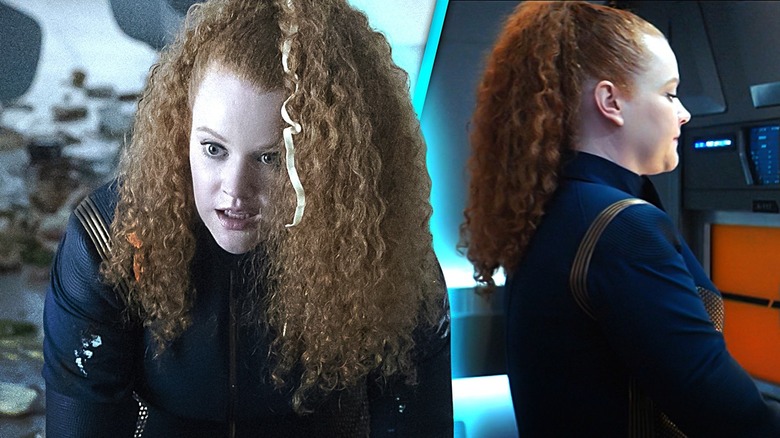
When we think of obstacles to interstellar or even just interplanetary travel, problems like fuel and cryosleep immediately come to mind. But one of the most significant problems humanity must overcome is how to provide nutrition for an entire crew during the months, years, or decades spent with nary a soil sample in sight. In the world of "Star Trek," there's a simple solution for feeding a ship's crew: replicators. Contrasted with today's world where most people toil away endlessly to keep up with the ever-inflating costs of food, clothing, and housing, the replicator represents the mark of a post-scarcity era, freeing humanity to focus on exploration and the pursuit of knowledge and the arts. The future's answer to microwave ovens, replicators are small enough to be installed in every room and accessible enough that a child can use them. Crucially, they are capable of creating just about anything a Starfleet officer could want (just as long as Starfleet's safety protocols and regulations allow for it). By the 24th century, replicators have become so ubiquitous that cooking has become more of a hobby or art form than a necessary life skill.
The ultimate recycling machine, replicators are the evolutionary successor of the protein resequencer technology seen in "Star Trek: Enterprise." Using transporter technology, they work by completely deconstructing matter and then reconstituting it into a desired product. But unlike Starfleet's existentially frightening transporters, which rely on molecular imaging scanners, replicators use a quantum geometry transformational matrix field to fill an order based on a stored pattern matrix — which is why if the ship can only create things it has a recipe for.
Replicators evolved from protein resequencers
When Starfleet first takes to the stars with the NX-01, they haven't yet developed replicator technology, instead relying on a combination of food from their hydroponic greenhouse, resupplied galley food, and food generated from the protein resequencer. Exactly how fundamentally world-changing replicator technology is to the world of "Star Trek" is driven home in the "Star Trek: Enterprise" episode "Dead Stop." While checking out an automated station, the crew encounters what T'Pol (Jolene Blalock) calls a "molecular synthesizer" similar to one she'd seen aboard a Tarkalian vessel, describing the device as "similar to a protein resequencer but far more advanced" and "capable of replicating almost any inanimate object."
After Trip Tucker (Connor Trinneer) orders a pan-fried catfish, T'Pol surmises that the technology must have scanned the Enterprise database to access a recipe stored in Enterprise's computer along with a copy of the catfish genome. Trip immediately observes that such a technology would revolutionize parts fabrication for the engineering department.
By the time of "Star Trek: The Original Series," the technology has advanced quite a bit, even if has not yet attained the standards Picard's crew will one day enjoy. How far they still have to go is referenced in "Charlie X" when Kirk (William Shatner) comments that he wants the crew's synthetic meatloaf to at least appear like turkey for their Thanksgiving celebration. Sometimes referred to as food synthesizers, these earlier models of replicator technology worked by using diet cards or tapes like those demonstrated by Nurse Chapel (Majel Barrett) in the "TOS" episode "And the Children Shall Lead."
Replicator food is recycled poop
Just like today's astronauts recycle their urine, Starfleet saves space by recycling other types of matter, even the kind we don't like to think about. Responding to a "poop question" from a curious group of schoolchildren in "Breaking the Ice," Chief Engineer Trip Tucker explains that like just about everything else aboard their starship, human waste is recycled in the biomatter resequencer. "The waste is broken down into little molecules and then they get transformed into any number of things we can use on the ship — cargo containers, insulation, boots — you name it," Trip specifies.
While the resequencers would eventually be replaced by replicators, the basic principle behind the technology remains the same a millennium later in the 32nd century, as emphasized by Fleet Admiral Charles Vance (Oded Fehr) in the "Star Trek: Discovery" episode "There is a Tide..." to Osyraa (Janet Kidder). After revealing that he had never eaten a real apple, Vance tells the Emerald Chain representative, "It's made of our sh**, you know. That's the base material that we use in our replicators. We deconstruct it to the atomic level and then reform the atoms." And although some audience members might find this "Star Trek" revelation somewhat horrifying, Vance is quick to add that all things considered, their reconstructed waste actually tastes "pretty good."
The mechanisms behind the replicator waste recycling system is further outlined in the "Star Trek: The Next Generation Technical Manual," which explains how the ship directly recycles anything it can. Anything that cannot be directly recycled gets broken down first including waste. As Michael Eddington (Ken Marshall) tells Benjamin Sisko (Avery Brooks) in "Star Trek: Deep Space Nine," they both know they're really eating replicated protein molecules and textured carbohydrates ("Blaze of Glory").
- More to Explore
- Series & Movies
Published Mar 23, 2013
Trek Class Blog: Inventing The Replicator
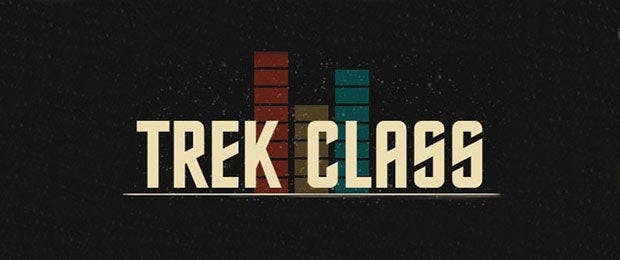
Inventing the Replicator by Professor Anthony Rotolo
Star Trek ’s replicator is an amazing technology concept that has fascinated us for decades. Working at the molecular level to synthesize materials, the replicator is able to instantly produce nearly any object, food or medicine on demand. It is easy to imagine how the replicator would quickly change the world. Such a device could dramatically reduce or even eliminate the cost of most products. Hunger and poverty would be stamped out worldwide, and much of the time and energy spent working for a living could be used instead for pursuits of education, exploration and the advancement of society.

Star Trek envisions the future of humanity to be one of incredible achievements made possible by evolved philosophies as well as technologies. This hopeful view of tomorrow is perhaps the reason so many have dreamed of inventing real-life versions of Star Trek tech -- from the transporter to the tricorder -- and the replicator is one of the most coveted.From a scientific perspective, aspects of the replicator are theoretically uncertain. Researchers have made slow progress working in this area, but a true breakthrough on the scale of a Star Trek replicator seems centuries away. The day when we will prepare dinner or produce complex equipment at the push of a button (or with a voice command) could be as far away as our own 24th Century.
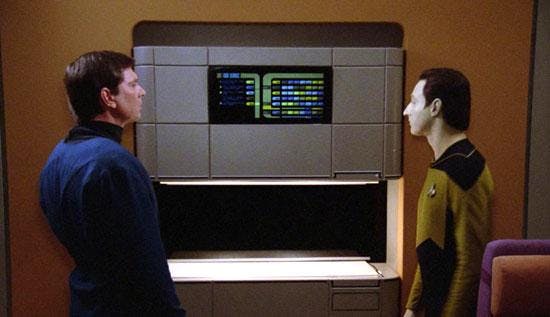
Even if the full vision of the replicator remains beyond our capabilities, perhaps some version of this technology is possible today. After all, the real appeal of the replicator is not in its molecule-synthesizing abilities, but in the value of instant, custom objects made on demand. This is a reality that some are working toward right now using new technologies that could eventually bring us much closer to making the replicator a reality.A process called “additive manufacturing,” or its more popular nickname, “3D Printing,” has captured the imagination of the tech industry. These machines work much like the two-dimensional printer you may have on your desk, but instead of printing a layer of ink, a 3D printer extrudes many layers of melted plastic to form a physical object. You can imagine this as similar to a hot glue gun, where the heated glue stick is carefully extruded from a nozzle. In the case of a 3D printer, that nozzle is controlled by software and digital design files that tells it how to form a shape.
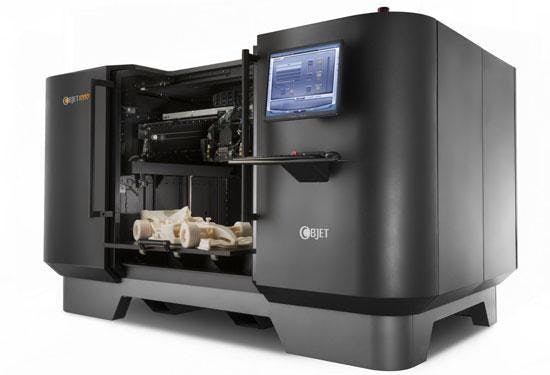
Some have compared 3D printers to modern-day replicators, and it’s easy to see how. Watching one in action is a wondrous experience, with objects that once had to be produced on a factory line fabricated in minutes by a machine not much larger than a microwave. Even complex objects with moving parts can be designed and created one-by-one with a little knowhow. It hardly seems like a coincidence that one of the more popular 3D printer models currently available is actually named the Replicator.The comparisons between 3D Printing and the Star Trek replicator don’t end with plastic. Other materials like wood, metal and even some foods are now being extruded in similar ways to make on-demand creations. This has led to excited speculation that soon we may see the beginnings of a new era of manufacturing in America and around the world, where small-scale production is possible at very low costs. We may even “print” biotechnologies and human organs one day.
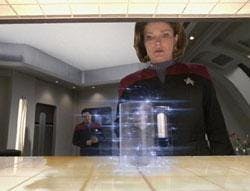
______________Anthony Rotolo is a professor at Syracuse University where he teaches “Trek Class.” He is also the founder and “Captain” of the “Starship NEXIS,” a lab that explores new and emerging technologies.
Get Updates By Email
Smithsonian Voices
From the Smithsonian Museums

SMITHSONIAN BOOKS
The Influence of Star Trek and Science Fiction on Real Science
For Star Trek Day, learn about the relationship between sci-fi and real-life science in this excerpt from “Reality Ahead of Schedule”
:focal(800x602:801x603)/https://tf-cmsv2-smithsonianmag-media.s3.amazonaws.com/filer_public/b0/96/b096b98c-3581-4361-a150-3b7e655816b9/starship_enterprise.jpg)
As with several other iconic Star Trek technologies, replicators are directly responsible for inspiring developments in real-life technology, which use 3-D printing to create food, meals, plastic and metal items, buildings, and even complex machine parts. Star Trek is far from being the only sci-fi source of inspiration for the dream of a device that can produce finished items from scratch.
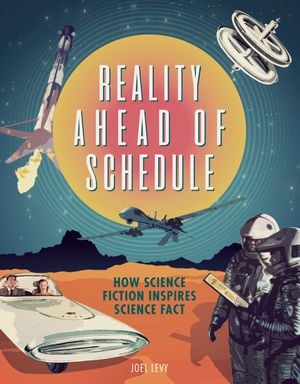
Reality Ahead of Schedule: How Science Fiction Inspires Science Fact
A rich visual history of science fiction's impact on real-world technologies, this book is perfect for lovers of H. G. Wells, Star Trek, Isaac Asimov, Jules Verne, Aldous Huxley, and 2001: A Space Odyssey.
To trace the roots of Star Trek ’s replicator, it is necessary to understand that it is essentially a repurposed form of the transporter—the teleportation or matter transmission device that “beams” the crew between starship and planet surface. According to legend, the transporter was invented only because the original series lacked the budget to film special, effect-heavy scenes of planetary landing shuttles, but Star Trek did not invent the concept of matter transmission. Its first appearance in science fiction dates back at least as far as 1877, in Edward Page Mitchell’s story “The Man Without a Body,” which prefigures George Langelaan’s much better-known 1957 story “The Fly,” by having a scientist experience a teleportation mishap when his batteries die while he is only partway through a transmission, so that only his head rematerializes. The replicator uses the same basic principle as the transporter, in which the atomic structure of a physical object is scanned and the information is used to reconstruct the object at the “receiving” end through energy-matter conversion. In practice, all transporters are replicators and matter “transmission” is a misnomer, because matter itself is not transmitted, only information. Every time Captain Kirk steps out of the transporter having “beamed up” from a planet’s surface, it is, in fact, a copy of him—the original has been disintegrated during the initial phase of the operation.
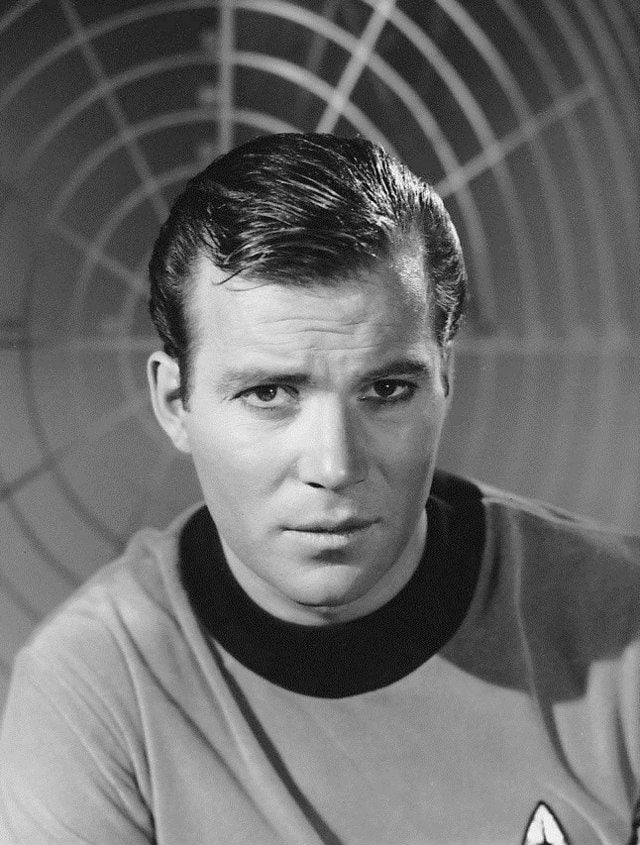
In the world of the TV series, the replicators of Picard’s Enterprise are a development of food synthesizers— simpler machines present on James Kirk’s Enterprise in the original Star Trek series (known as The Original Series , or TOS). These closely resemble the later replicators but were conceived by the writers of TOS more as highly advanced, mechanical food preparation devices instead of matter-energy converters. They, therefore, represented a televisual outing for a concept long popular in science fiction: the automatic food preparation device. A machine that performs complex autonomous physical tasks can reasonably be described as a robot, and, as early as 1899, Elizabeth Bellamy’s novel Ely’s Automatic Housemaid features a robot cook, which might be seen as a precursor to later food synthesizers. Unspecified “mechanical apparatus” was at work in the automated cafeterias of Edgar Rice Burroughs’s Mars. In his 1912 A Princess of Mars , Burroughs, probably inspired by the automat (a kind of vending machine café imported from Germany to the United States in 1902), describes “gorgeous eating places where we were served entirely by mechanical apparatus. No hand touched the food from the time it entered the building in its raw state until it emerged hot and delicious upon the tables before the guests, in response to the touching of tiny buttons to indicate their desires.”
Moving from Burroughs’s mechanical cafeterias to a Star Trek -style food synthesizer was simply a matter of miniaturization, and, by 1933, David H. Keller was imagining “a small but complete production laboratory, not much larger than [an] electric refrigerator … entirely automatic and practically foolproof.” In his story “Unto Us A Child Is Born,” Keller envisages a machine that can both create food and prepare it “for the table in any form desired by the consumer. All that was necessary was the selection of one of the twenty-five menus and the pressing of the proper buttons.” Only recently has this dream of a kitchen appliance-scale food synthesizer neared reality, with the launch of the Genie food replicator, explicitly inspired by Star Trek ’s replicator. The Genie, a device not much larger than a microwave with futuristic styling, claims to be “a kitchen in a box” that can make nutritious, freshly cooked meals in 30 seconds. However, it should be noted that the device relies on pods that contain dehydrated ingredients; in other words, the food preparation labor has simply been moved upstream in the process, and the Genie might be little more than a device for adding hot water to a cup of dried noodles.
/https://tf-cmsv2-smithsonianmag-media.s3.amazonaws.com/filer_public/97/87/9787a907-dd0b-4106-9b64-6e4c849f0ff8/3d_printer.jpg)
So what is meant by today’s technology boosters when they talk excitedly about Star Trek -inspired, real-life replicators? The technology to which they refer is the 3-D printer, a device that lays down some form of plastic (in the sense of malleable) medium in layers to build up a three-dimensional form. Such printers are heralded as the drivers of a second Industrial Revolution, in which manufacturing is distributed and universal, available to all through desktop 3-D printing machines. These devices are already available, usually restricted to fabrication using quick-setting plastics or resins, but larger and more specialized machines can print in media varying from living cells and foodstuffs to metal to mud or concrete. Large-scale concrete printers, for example, are suggested as a solution to housing crises, such as those found in refugee camps, where rapidly assembled, cheaply erected structures are needed. Meanwhile, biological implants and replacement tissues can be printed by laying down layers of cells on organic scaffolding, and, in the near future, it may be possible to print entire organs for transplant.
Although the 3-D printing community often plays up the lineage of inspiration from Star Trek ’s replicators to desktop fabricators, in practice, the former has a completely different mechanism. The true conceptual forefather of the 3-D printer is a 1964 story by Italian writer Primo Levi, “L’ordine a buon mercata” (“Order on the Cheap”). A mysterious multinational enterprise of dubious intentions makes available a device called the Mimer duplicator, which can create exact replicas of anything from money and diamonds to food and humans. It works by extruding “extremely thin superimposed layers” of a multielement substance named “pabulum.” This is a concise and extremely accurate description of how a modern-day 3-D printer works.
Star Trek featured gadgetry and devices that have since become iconic, and that have been directly responsible for inspiring the gadgetry and devices that have come to dominate modern personal technology—including the smartphone and the tablet computer—and perhaps soon to include portable, personal medical devices. Science and technology sometimes progresses in mighty leaps, but more generally it advances incrementally, contingent on prior research.
Reality Ahead of Schedule: How Science Fiction Inspires Science Fact is available from Smithsonian Books. Visit Smithsonian Books’ website to learn more about its publications and a full list of titles.
Excerpt from Reality Ahead of Schedule © 2019 by Carlton Books Limited
It’s a wonderful world — and universe — out there.
Come explore with us!
Science News Explores
Could star trek replicators exist.
Experts break down what’s possible and what’s not for this sci-fi invention
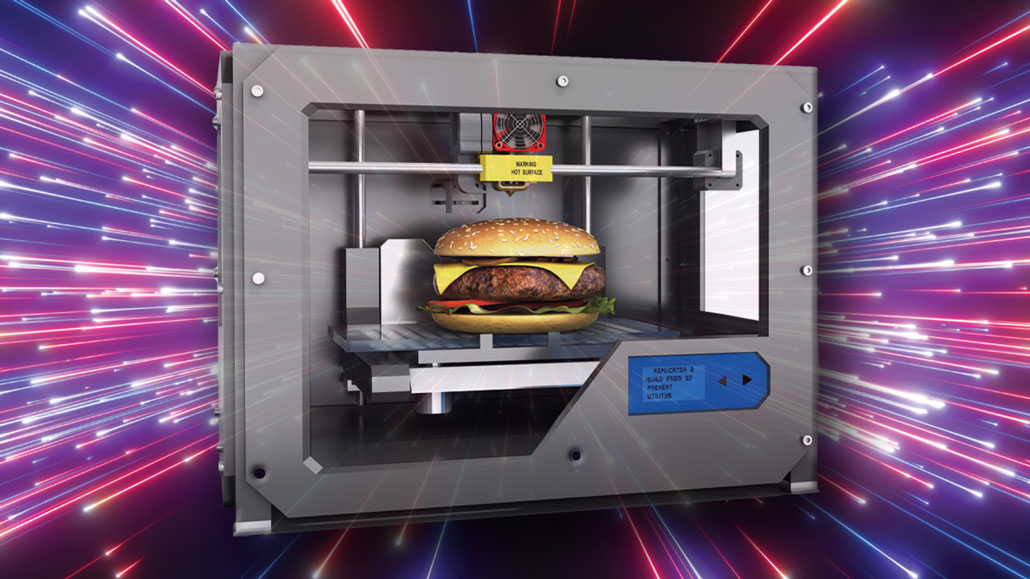
It’s not quite a replicator, but maybe future space travelers will be able to 3-D print dinner on demand.
REPLICATOR: WACOMKA/SHUTTERSTOCK; BACKGROUND: NOSOROGUA/SHUTTERSTOCK
Share this:
- Google Classroom
By Deborah Balthazar
September 5, 2023 at 6:30 am
Let’s say you’re hungry. Wouldn’t it be great to walk up to an appliance, tell it what food you want and have that food appear magically in front of your eyes? In the TV franchise Star Trek , this is possible with a piece of technology known as a “replicator.” Getting to a future where this tech exists, though, might take a bit of imagination and invention.
The Star Trek replicator is used to make all kinds of objects, from a hot cup of Earl Grey tea to spare parts for spaceships. Biowaste and other recycled material is broken down into basic parts: water, carbon and other molecules , explains Erin Macdonald. She’s an astrophysicist and science advisor for the Star Trek franchise. Those molecules are then fed into the replicator. When a person asks for an item, lasers reassemble the bits according to a recipe in the computer until it looks like that cup of tea, a dish of mint-chocolate-chip ice cream or a piece of a warp coil.
What, exactly, is the biowaste that goes into the machine? It will probably include poop, says Macdonald. “We don’t want to think about that too much.”
Educators and Parents, Sign Up for The Cheat Sheet
Weekly updates to help you use Science News Explores in the learning environment
Thank you for signing up!
There was a problem signing you up.
The replicator’s superfast lasers convert incoming matter into energy. Then, they change it back into matter . “On a fundamental level, there is nothing that prevents you from building a replicator-like machine,” says Gianluca Sarri. He’s a quantum physicist who works with lasers at Queen’s University Belfast in the United Kingdom.
But a replicator is just not a top priority at the moment, he says. All that conversion of matter to energy back to matter again would require a lot of energy. Plus, there’s no way to currently make an object appear within seconds. What’s more: Right now food can be generated in a much simpler way — by cooking.
Let’s print a meal
For now, astronauts eat food sent up from Earth. To make sure they get the food they need, future space tourists and crews might rely on hydroponics — growing plants without soil. Cooking that food in space like you do at home might be an option. But it might not always be practical inside the tight fit of a spaceship. So spacefarers might instead print that meal with a 3-D printer.
Today’s 3-D printers are similar to regular printers, notes Jonathan Blutinger. Just as normal printers must be fed cartridges of ink, 3-D printers must be fed cartridges of printing material. Blutinger is a design engineer.
While at the Creative Machines Lab at Columbia University in New York City, he helped create a 3-D printer that acts like a digital chef. “The printer will not allow you to make something from nothing,” he says. “You need to start with the right base ingredients.”
Blutinger’s group recently started with ingredients for a “cake.” They put graham-cracker paste, strawberry jam, peanut butter, Nutella, cherry drizzle, banana puree and frosting into the food printer. The printer assembled and cooked the ingredients with lasers to make a slice of cake.
The cake tasted great, Blutinger says, but it was definitely a unique experience because the flavors came in “waves.” The group’s paper about the cake appeared March 21 in npj Science of Food .
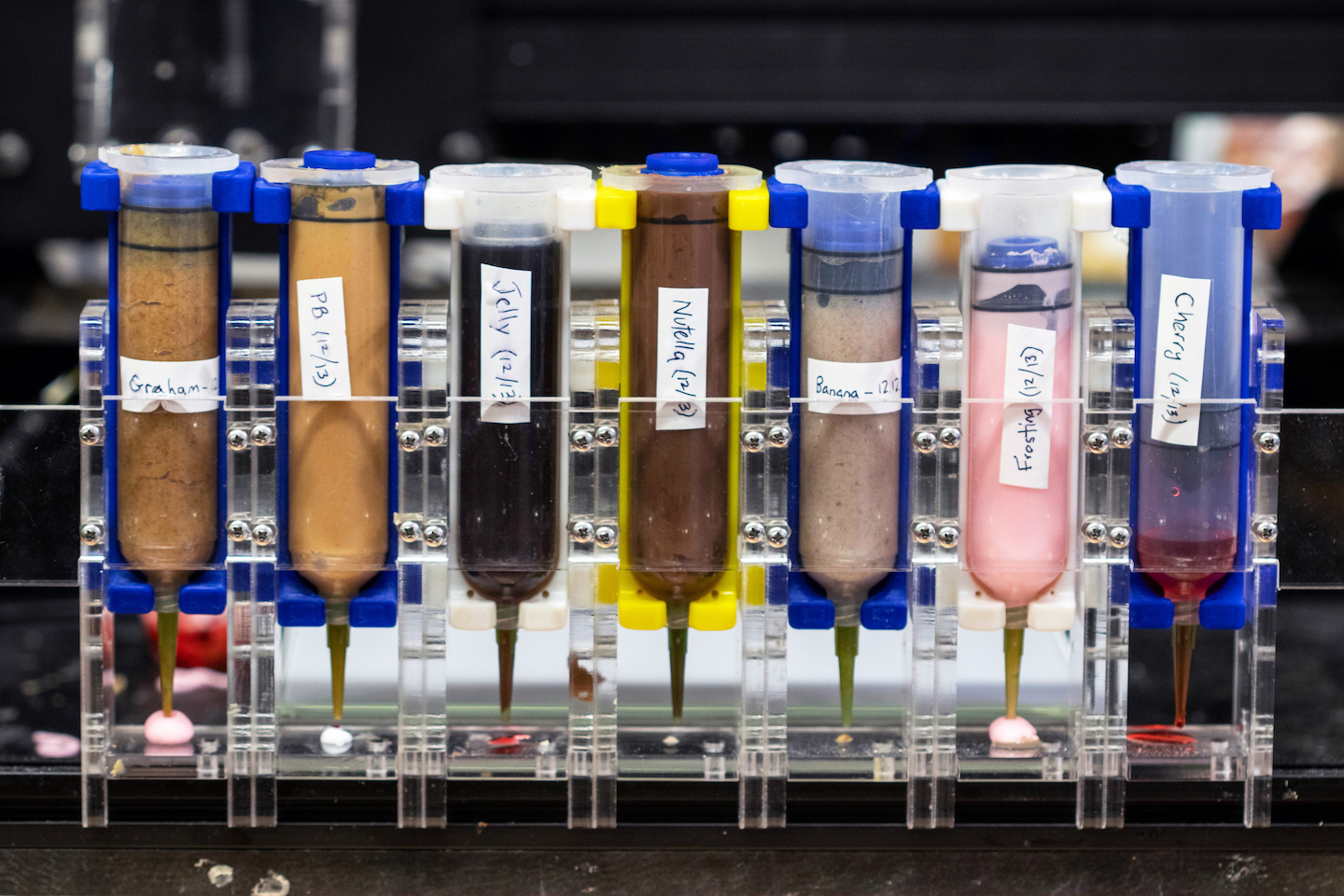
Appetizing or off-putting?
The 3-D printing robot chef can only assemble the ingredients it’s given and then add heat to cook the food. It cannot create foods from pure energy made from biowaste, like the fictional Star Wars replicator does. But people may not yet be comfortable eating even this relatively simple version of machine-made meals, Blutinger says.
Most people are comfortable with items like flour and peanut butter because we know where they come from. As science moves food away from the source, though, people could get grossed out. That 3-D printed cake might be easier for some to eat than 3-D printed meat, for instance. And people who did not grow up with 3-D printers in the kitchen might prefer food from the grocery store, Blutinger says.
“But pretty soon…kids will be growing up with these kinds of food robots in their kitchen,” he predicts. “Then that’s all they’re going to know.”
Macdonald agrees. “It’s just one of those things that people will have to come to terms with.”
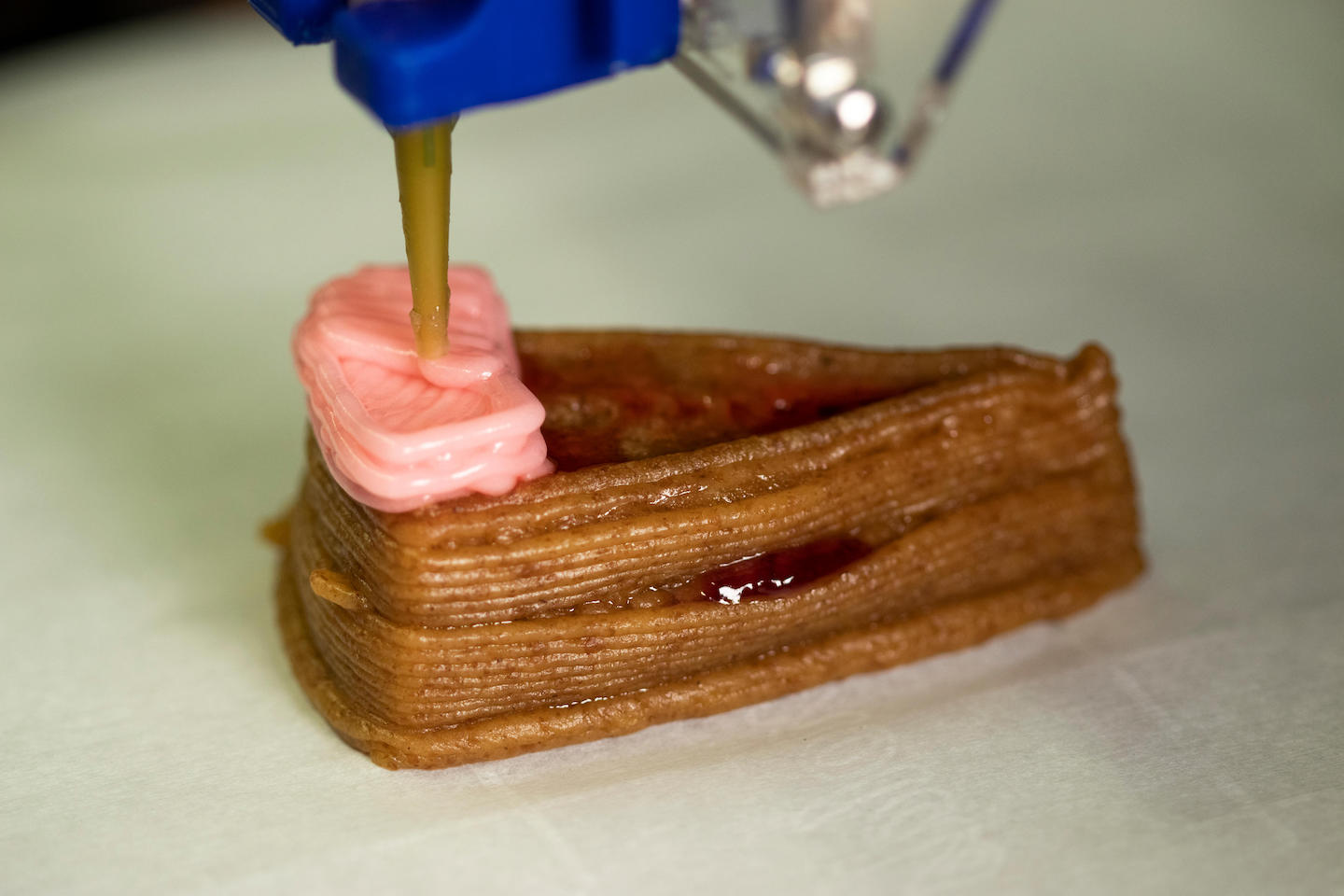
Food printers might be on our kitchen counters within the next 10 to 20 years, Sarri says. These printers could be like “having a personal chef and nutritionist all in one,” Blutinger adds. The machine could someday recommend and create healthier food that’s customized to your diet.
A Star Trek replicator might be possible, but not nearly as soon, says Sarri — maybe 100 years down the line. Those replicators of the future could be useful in areas in beyond outer space. They could provide food in places where putting a chef might be dangerous, such as a war zone.
“There’s a feedback loop,” Macdonald says, “of scientists being inspired by Star Trek and then making that science. And then that continues to feed into the science fiction of, ‘Well this is what we can do now, so what’s next?’”
The next tech to materialize might just be a replicator.
More Stories from Science News Explores on Tech

Soccer-playing robots show how nimble AI-powered machines can be

Holey basketballs! 3-D printing could be a game-changer

Teen’s battle simulator could help Ukraine’s troops fend off attacks

Does AI steal art or help create it? It depends on who you ask

AI image generators tend to exaggerate stereotypes

This computer scientist is making virtual reality safer
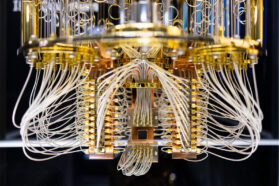
Here’s why scientists want a good quantum computer

The desert planet in ‘Dune’ is pretty realistic, scientists say
Star Trek: The Next Generation Nixed A Major Promotion For Captain Jellico
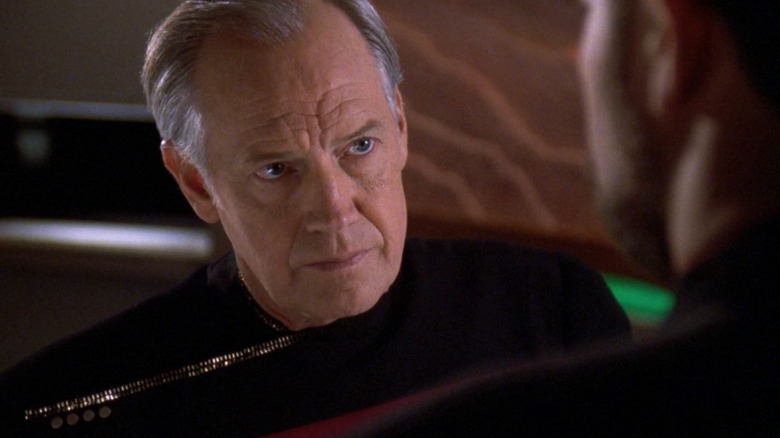
In the 1992 "Star Trek: The Next Generation" episode "Chain of Command, Part I," Captain Picard (Patrick Stewart), Dr. Crusher (Gates McFadden), and Lieutenant Worf (Michael Dorn) are called away by Starfleet to undertake a dangerous, very secret mission to seek out and apprehend a dangerous biological weapon being developed by the untrustworthy Cardassians. Picard needs to resign as captain of the USS Enterprise in order to undergo this mission, and he is replaced by one Captain Edward Jellico (Ronny Cox), a commanding officer with a dramatically different managerial style.
As a captain, Picard was open to suggestions, careful to keep a rapport open with his crew. Jellico, meanwhile, was stern, cold, and loved to micromanage. He hated casualness and jocularity, and expected everyone to be tightly wound. He wasn't a bad captain — indeed, he was quite good — but he was a terrible boss. The appearance of Jellico set many Trekkies' hearts aflame, as he reminded us that starship captains were always going to be temporary, and that a career in Starfleet will often throw unexpected curveballs at the crew, even someone as established as Picard. Jellico also reminded us that there is a wide variety of command styles in "Star Trek" ; not every captain is going to be as warm or open-minded as Picard.
At the end of "Chain of Command, Part II," Jellico relinquished command of the Enterprise back to Picard and the comfortable status quo of "Next Generation" was restored. The character wouldn't be seen again until the "Star Trek: Prodigy" episode "Masquerade" in November of 2022.
But, according to Larry Nemecek's invaluable sourcebook "The Star Trek: The Next Generation Companion," Jellico almost made an appearance in the 1993 episode "Tapestry," back in command of the Enterprise.
Jellico can and Jellico do
The premise of "Tapestry" is intense : Picard dies after suffering a phaser blast to the chest. He awakens in the afterlife, greeted by the playful space deity Q (John De Lancie). Q explains to Picard that his artificial heart malfunctioned, and that if Picard had an organic heart, he would have survived the phaser blast. Picard explains that he lost in heart in a knife fight when he was 21, having instigated a bar brawl with some 7-foot-tall Nausicaans. Q offers to send Picard back in time to rewrite history, stop the brawl, and save his heart. Picard accepts.
The adult Picard, however, had forgotten how impulsive and irresponsible he had been at age 21, and is shocked to find how reckless his friends were. He tries to apply his adult wisdom to his younger self, and he manages to stop the bar brawl he instigated. In so doing, however, Picard alienates his friends, displays a distinct lack of daring, and emerges on the other side cautious, callow, and weak-willed. Wisdom, he finds, cannot be directly applied to youth. He needed to learn by making mistakes.
When Q whisks Picard back to his adult life, now with his organic heart intact, everything is altered. Picard is now a lowly lieutenant on the Enterprise, having made it to his 60s with no career ambition.
The captain of the Enterprise in this altered timeline is said to be a previously unmentioned character named Thomas Holloway. But in the original draft of the "Tapestry" script, writer Ronald D. Moore wanted the alternate Enterprise to be commanded by Edward Jellico. Moore decided against it, though, perhaps feeling that the reference was too insular.
Ronald D. Moore's plan for Jellico
Moore's plan for Jellico was laid out plainly in Nemecek's very thorough book. But before Nemecek could explain it, he had to go into detail about Picard's career arc as a means to illustrate how reckless he remained, even after being stabbed in the back in "Tapestry." To digress briefly: Recall that on the original "Star Trek," Kirk went on away missions all the time. On "Next Generation," Captain Picard always stayed on the bridge, likely because it's a wise rule for Starfleet to have. Through several "TNG" episodes, Picard mentioned that he was still going on away missions while stationed on the USS Stargazer, which, Trekkies know, was Picard's first command. Evidently, something Picard did on the Stargazer inspired Starfleet's rule that captains are banned from away missions. Nemecek laid out all the complex mythology like this:
"Unaware of Bob Justman's formative idea to credit the ban on captains' dangerous beam-downs to Picard, Moore said the brief mention of just such an instance with Picard taking command was meant to show that his 'twenty-two-year mission' on his old ship as laid out in [Gene Roddenberry's] original Writer's Guide was not all spent as captain. Also, he added [...] Jellico ('Chain of Command') was his later-nixed first choice for Enterprise's captain in Picard's altered future."
Moore doesn't say, however, if Jellico was only going to be mentioned as the captain of the Enterprise in the alternate "Tapestry" future, or if the character would appear on camera. It might have been fun to see the callow version of Picard and the unaltered version of Jellico have a conversation. One can see why Jellico was ditched, though. Trekkies would likely be too busy yelling "Hey, it's Captain Jellico!" to fully absorb that Picard's life is now hollow and pathetic.
In the animated series "Star Trek: Prodigy," Jellico was seen to have achieved the rank of Admiral ... and he was just as snippy and petty as he always was. It turns out even micromanaging a-hole captains can rise through the ranks.
Create a free profile to get unlimited access to exclusive videos, sweepstakes, and more!
Star Trek replicator finally replicated by real-life scientists
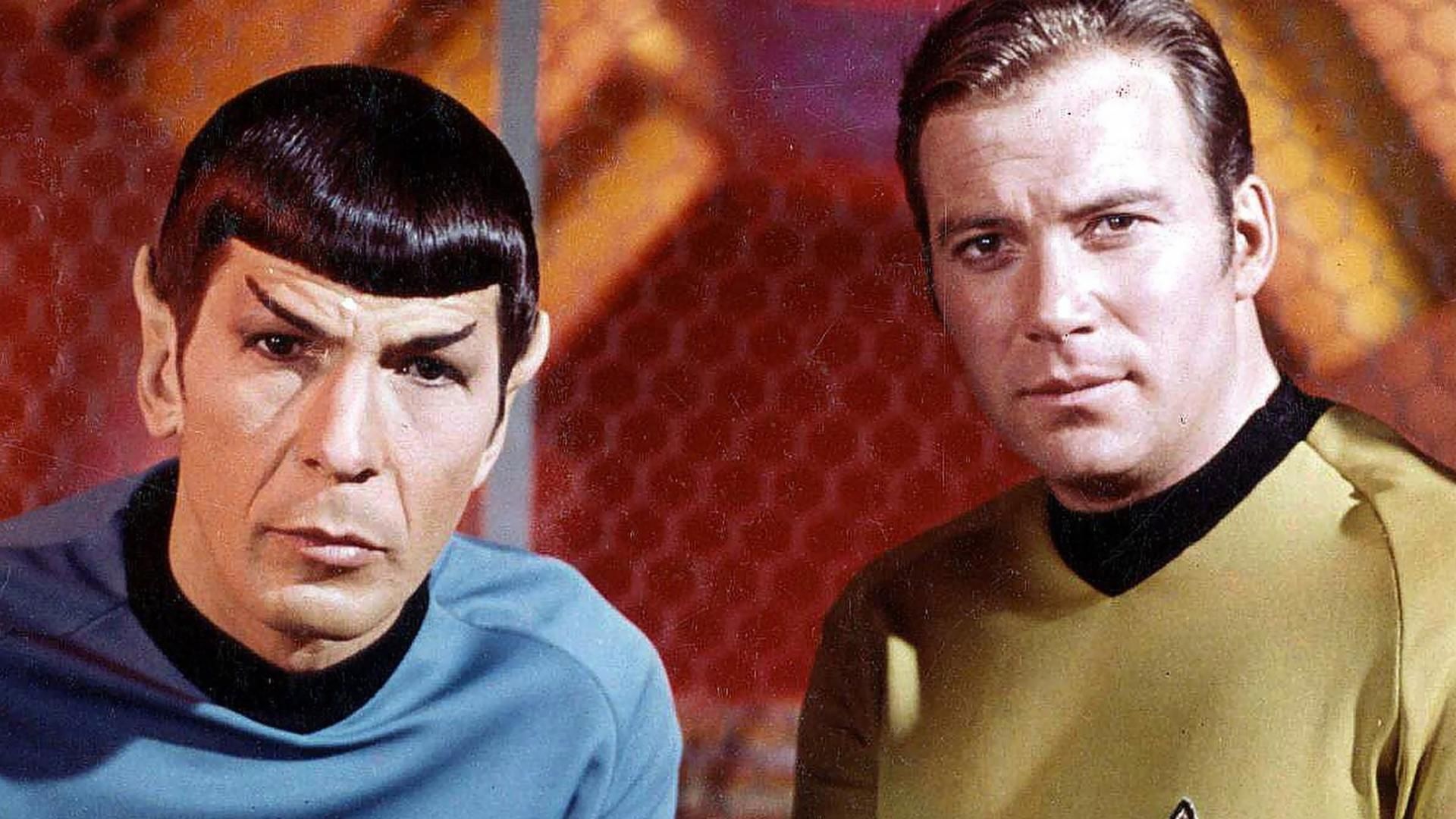
Credit: CBS Studios Inc.
Star Trek has been prescient about future technology ever since showing off a nascent cell phone in the pilot episode of the original series. But that doesn’t make the creation of this real-life replicator any less astonishing.
Throughout the incarnations of Star Trek , the replicator has produced a variety of human necessities to the good Starfleet folks exploring the outer reaches of space, primarily food and drink, but also spare parts, uniforms, and even breathable air. But as far as we know, they never instantaneously produced a miniature replica of Rodin’s “The Thinker.”
Intrepid researchers from Lawrence Livermore National Laboratory and the University of California, Berkeley have done just that, and created a wholly different approach to 3D printing. Amazingly, it looks very much like Star Trek’ s replicator, but instead of fictionally dismantling objects into sub-atomic particles or actually slowly 3D printing something layer by layer, the new approach projects light into resin, which produces small objects in a matter of minutes.
The new technology is based on the principles of computed tomography (CT), frequently used in medical and industrial 3D imaging, but never before used in the process of fabrication. But where traditional 3D imaging takes multiple X-rays to produce a 3D map, this tech reverse engineers the 3D object into 2D components, which are then projected as slides of light into the gooey resin.
"We saw that the underlying theoretical framework of CT could be adapted in a powerful way to generate arbitrary 3D geometries by building up a light dosage distribution within a volume of light-sensitive material from many different illumination angles," electrical engineer and UC Berkeley assistant professor Hayden Taylor told SYFY WIRE via email. "Once we had made the initial demonstration of the technology, the analogy with 'The Replicator' suggested itself to a couple of the students working on the project, and it stuck!"
“Our new process is called Computed Axial Lithography (CAL), and prints entire 3D objects into light-sensitive materials all at once,” Taylor told Digital Trends . “The process involves rotating a container of light-sensitive material, while projecting into it a sequence of computed light intensity patterns that are synchronized with the rotation. Over time, a 3D pattern of light energy is delivered to the material by more than a thousand different projections. Where the energy delivered exceeds a critical threshold, the material undergoes a chemical reaction and the part is formed.”
Check out the Nature Video above to get a better understanding of the process, or read the paper, "Volumetric additive manufacturing via tomographic reconstruction," published via Science .
This is impressive tech, no doubt, and will likely lead to a wide range of printable opportunities, including much larger objects.
"We expect (but have not yet shown experimentally) that it should be possible to print objects up to 0.5 meter diameter with features down to 0.1 to 0.2 mm at a rate of several liters per minute using a high-end 4K projector," Taylor told SYFY WIRE. "Of course there will no doubt be plenty of engineering challenges to be addressed on the way, but we have not yet identified an insurmountable limitation to scaling of the process."
So who knows, maybe they’ll be able to replicate that transporter we’ve all been hoping for.
Related Stories

Where to Stream the Jaws Movies This Summer

Before the Dark Universe, Van Helsing Was a Wild Remix of Universal's Monsters

'John Wick Puppy Scene Was Briefly Removed from Script

Where Is The Continental Hotel Located In New York City?

Why Don't People in Ghostbusters Remember the Ghosts?

Abigail Blu-ray & DVD Bonus Features Date and Details

Monkey Man Streaming Exclusively on Peacock: How to Watch

Why Alice Eve's Carol Marcus Didn't Return in Star Trek Beyond

John Wick Easter Eggs in Peacock's The Continental

Everything We Know About the New Jason Bourne Movie
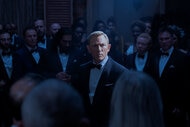
Daniel Craig Explains Why His James Bond Had to Die

Dream Chaser Space Plane Prepares for First Flight to ISS
Recommended for you.

Linda Hamilton on Resident Alien Role: "I'm Not the Funny Girl, I'm the Straight Man"

The Classic Twilight Zone Episode That Inspired Jordan Peele's Us

Resident Alien's Alan Tudyk on Harry's New Love Interest, Edi Patterson's Blue Avian
How Are The Replicators Supposed To Work On Star Trek?
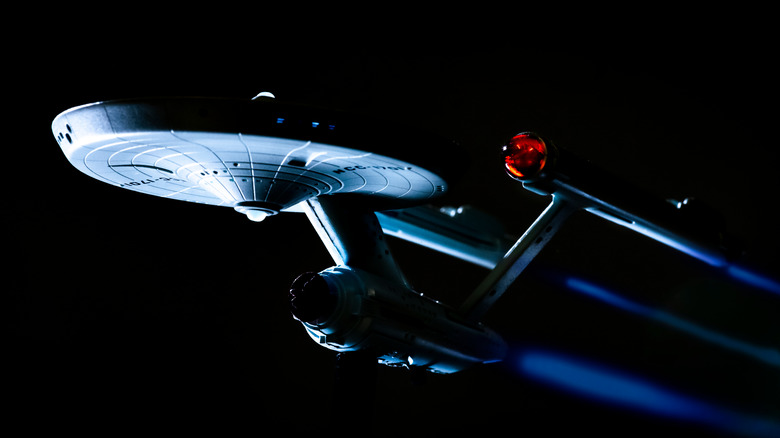
Coffee, black, or Earl Grey, hot? If you're a "Star Trek" fan, you've probably heard a character or two say these words. You might think of Captain Kathryn Janeway of "Star Trek: Voyager" and Captain Jean-Luc Picard from "Star Trek: The Next Generation" and "Picard" are just big breakfast drink fans, and they are, but they're also busy leaders of working space starships. They needed a way to get their favored drinks fast. So they turn to their replicators.
Replicators are essential machines in the "Star Trek" universe. This device can reproduce food, tools, and sometimes even random viruses. Depending on the writer's imagination, it can make almost anything. In times of need, the replicator is the only thing that can feed the crew. And being so far from Federation ports and basses, replicators were their best bet in getting that one part they need to fix their warp core containment.
While the replicator has made many appearances on the shows — Janeway even took hers apart in one episode — it's remains a tool of mystery to many. It acts a lot like a transporter, because it kind of beams food. So how are these things imagined to work in the first place? Of course, this is a starship, and the explanation is very sci-fi.
It's kinda gross, really
According to the "Star Trek" website , the reason some people see replicators as mini-transporters is because, well, it technically is one. In "Star Trek," transporters "beam" people and items to different places. They dematerialize matter and reconstitute it somewhere else. The replicator essentially acts the same way. So what matter does it work with? Comic Book reported the not exactly appetizing news. An episode of "Star Trek: Discovery" explained the material comes from fecal matter.
Replicators cannot make new matter because physics simply doesn't allow for that. In the "Trek" universe, scientists had developed a mixture of different materials specifically for food replicators, but it was a finite resource. And so the resource-poor Federation of Planets used something humanity never runs out of: Its own waste. The episode suggests that this sacrifice doesn't come at a human cost, which means the Federation can still claim the moral high ground against their enemies.
Replicators have been in use since the 24th century in the "Trek" universe , though very little has changed around the technology. No matter how advanced, a replicator will only make food programmed into its system. Even so, it beats having to sacrifice a lot of cargo space just to bring thousands of boxes of popcorn. Replicated food will taste mostly the same as the food it mimicked and will also have the same nutritional density. However, that has never stopped intrepid starship captains from bringing the real thing.
Real-life version
Having a replicator certainly means an ability to reproduce just about anything you can think of, provided it's programmed into the machine. So it's very easy to fall into the trap of featuring it in every episode. Bleeding Cool wrote that "Star Trek" writer and producer Ron D. Moore hated the replicator, and so did most people in the writer's room.
Moore said the replicators made everything too easy. If they were stuck somewhere, a character could just replicate something to get them out of a jam. So the writers sometimes avoided using replicators altogether in their episodes.
Fine, in a narrative sense, replicators may make things too easy. But imagine if there was a real-life replicator available. Then, we'd maybe get rid of food deserts once and for all. Fortunately for us, scientists have been working on recreating replicator technology. Per SyFy , researchers at the University of California, Berkeley invented a machine that projects light onto resin to produce an object in minutes. It doesn't re-materialize matter from subatomic particles, but it sure beats waiting hours watching a 3D printer squeeze out plastic.
The technology is based on computed technology, the kind of thing used in medical 3D imaging. The scientists call their new process computed axial lithography. It's not yet fully commercially available, so until then, we're stuck watching our favorite characters eat food replicated from poop.
Den of Geek
Star Trek Just Fixed One of the Worst Voyager Characters
Star Trek: Prodigy gives Chakotay a purpose his character never had on Voyager.

- Share on Facebook (opens in a new tab)
- Share on Twitter (opens in a new tab)
- Share on Linkedin (opens in a new tab)
- Share on email (opens in a new tab)
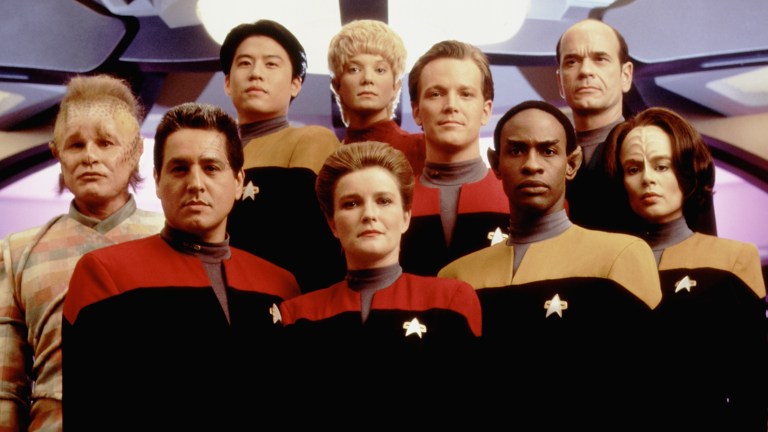
This Star Trek: Prodigy article contains spoilers.
For decades, Chakotay represented one of Star Trek ‘s greatest failures. Chakotay was introduced in Star Trek: Voyager as the franchise’s first Native lead character, a course correction from Trek ‘s embarrassing depictions of Native culture in the past (see “The Paradise Syndrome” from The Original Series and “Journey’s End” from The Next Generation ).
Whatever producers’ intentions, Chakotay made matters worse. Not only did they fail to cast a Native actor in the part ( Robert Beltran is Mexican American) but they hired a scam artist who called himself Jamake Highwater as consultant on the character, despite the fact that he had already been exposed as a Jewish man who pretended to be Native.
Making matters worse, producers lost interest in Chakotay after the third season of Voyager , giving him less to do, much to Beltran’s frustration. Hoping to get released from the show, Beltran increasingly demanded more money, but producers always agreed—not a bad gambit, all things considered, but Beltran’s disinterest in the character made Chakotay’s limited appearances a real drag.
Ad – content continues below
In short, Chakotay seemed like the character least likely to return for any of Star Trek’s modern sequel series, even as Prodigy made Janeway’s search for her former XO a key plot point. So imagine Trekkers’ surprise when the Prodigy kids finally find Chakotay in season two—and that Chakotay completely rules.
We learn in the new season that Captain Chakotay has been stranded on an empty planet with his disabled starship the USS Protostar , a holographic reproduction of Janeway his only companion after the death of his commanding officer. By the time the kids arrive, Chakotay has settled into a deep despair, going through the motions to survive, but nothing else.
The appearance of the kids gives Chakotay hope, but not really because they have ideas that help restore the Protostar . Rather, the kids give Chakotay a crew, and thus a purpose. In the two-parter “Last Flight of the Protostar ,” Chakotay directs the new arrivals in various tasks, getting them to work efficiently as they get the Protostar back into space.
The depth of Chakotay’s development can be heard in Beltran’s voice acting performance. At the start of the storyline, Beltran gives Chakotay the same flat affect he used in the later seasons of Voyager , when the character had no reason to exist on the series. But when Chakotay finds a purpose with the kids, Beltran’s voice becomes crisp and sharp. Beltran keeps the same warmth of the best Chakotay episodes, but adds an authority rarely seen on Voyager .
Chakotay’s best moment comes late in the story, when he consoles Dal, the self-appointed leader of the kids. Dal feels like he’s failed as a future captain, which leaves him without direction. “When I was your age, I was lost too,” Chakotay tells Dal. “Lost my father, my heritage, my purpose.” He explains that the lack of direction led to his involvement in the anti-Federation resistance army the Maquis, his status at the start of Voyager . According to Chakotay, service on Voyager restored the purpose he thought he had lost forever. It brought him back to the Federation and helped him become a great Captain.
Moreover, the statement helps give context to not just Chakotay’s decision to join the Maquis, but also his relatively easy return to the Federation. One of the great missed opportunities of Voyager was the way it never addressed the fact that half of the ship’s new crew were anti-Federation terrorists. Once Voyager stayed in the Delta Quadrant after the pilot episode “Caretaker,” everyone more or less fell in line under Janeway.
Chakotay’s speech in Prodigy reveals that, at his heart, he was always a Federation member. Unlike, say Michael Eddington from Deep Space Nine , he never saw himself as a freedom fighter against the Federation. Rather, he was just lost and looking for a purpose, which the Maquis provided for a time, until Janeway made him XO of Voyager and he found his role again.
Get the best of Den of Geek delivered right to your inbox!
Even more important might be what Chakotay doesn’t say in Prodigy . There’s no mention of the bones of his people, no declaration of “Akoocheemoya.” Instead, he simply mentions that he lost his heritage, a statement broad enough to retain the character’s Native heritage, but never recalls the nonsense that White producers made a Mexican American actor say to signify Indian-ness to non-Indigenous audiences. Is it as good as getting proper Native creators and actors in Trek ? No, not at all. But it is the best case scenario for a massively mishandled character.
No one watching Voyager would have believed that Chakotay would make for a believable Captain, let alone a compelling character. With Prodigy , Chakotay is a proper character, one with a real heritage and a real purpose, a character who belongs among the Star Trek greats.
Star Trek: Prodigy season two is now streaming on Netflix.

Joe George | @jageorgeii
Joe George’s writing has appeared at Slate, Polygon, Tor.com, and elsewhere!
Star Trek: How Do Replicators Work?

Your changes have been saved
Email Is sent
Please verify your email address.
You’ve reached your account maximum for followed topics.
Star Wars inspired Another Iconic Franchise's Season Finale
The legend of zelda movie needs one key visual element, x-men: 8 actors who could succeed hugh jackman as wolverine.
The Star Trek universe is arguably one of the most interesting sci-fi creations of our time. It cleverly combines human social commentary with a broadening spectrum of possibilities for the future. Star Trek contains many possible answers to everyday problems that exist in modern society, but also paves the way for technology that is theoretically feasible to be created in the future. These technologies are based on principles already being discussed and trialed within the world today. One example is the transporter, which allows matter to be deconstructed and then reconstructed in a different place, essentially allowing teleportation. Another is the Warp Drive, allowing ships like every iteration of USS the Enterprise to bend time and space. This allows them to to travel from one end of the galaxy to another, faster than the speed of light.
But one of the most incredible pieces of technology in the Star Trek Universe are replicators. These gadgets can recreate matter of all kinds, from substances like wood and metals, to material objects, to food fit for human consumption. Although this may seem at first like it would create an absolute utopia where no one ever has to go without, there are several things that get in the way of solving world hunger, one replicator at a time . These include societal constraints of access to the replicators as a monetary commodity which are unaffordable. There are also limits to the functions of replicators themselves, which have their own list of rules that their technology must adhere to. Knowing this, how does this miracle technology work?
RELATED: Star Trek: Who Was Lwaxana Troi?
When replicators were introduced as a staple use for the Federation in The Next Generation , they were explained as being able to reconstitute inanimate matter, by essentially cloning the original material that is placed into the scanner. The computer would ingest all the individual components or cells of the object, and then produce an exact copy of them cell by cell. It then reproduces those to create an artificial version of the original item.
Unfortunately, as this is a complicated process, the output of the replicator is never as good as the original version. Often, the food doesn’t taste the same, or the clothing doesn’t retain the same color or feeling as the original. It is important to remember that the replicators may be recreating an original that was scanned several decades ago. As such, it may have produced a diluted version of that original object. This is just one reason why the Federation are against using replicators to recreate organic or living material. For example, they would not allow replicators to recreate organs, or entire human bodies, despite it being theoretically possible.
Replicators do not work like Star Trek’s transporter technology . Transporters essentially take all the components of the original things and simply reconstruct it elsewhere. It's like building a structure out of Lego bricks in the living room, taking it apart to its individual pieces, and then rebuilding it in the garden. On the other hand, replicators do not retain the original material. Rather, they recreate a separate version of it, a version that is often considered lesser in some ways. In using replicators to try to recreate life or living matter, the Federation would be going against the fundamental moral and ethical guidelines of their organization. So although it is demonstrated to be possible by other races in the series, it is strictly prohibited by the Federation.
Beyond the ethical limitations placed on replicators by the Federation, there are technological limitations to how they work as well. The replicators work primarily by converting energy into matter. While the specifics of this are not officially canon, the general consensus is that they use the energy they are fed to rearrange an array of easily accessible atoms into whatever they are asked to create. Things like food and clothing are fairly simple (at least for a futuristic sci-fi supercomputer), because they are made of accessible molecules that are simple to create molecules. A t-shirt, for example, is most likely made from 100% cotton. Cotton is composed of pure cellulose, a polymer that is made up of hydrogen, carbon, and oxygen atoms. These are all easily accessible and creatable for the computer.
The more complex the creation, the more power the replicator needs. This concept is explored in the Voyager series, where power is limited and each member of the crew has replicator rations to help save energy. Tom Paris, argumentative ship pilot, uses a replicator to create a gold locket. This is suggested to have taken up a lot of his rations, as it was much harder for the machine to create. On other ships not restricted by power, this is still an issue. No ship in the Star Trek universe possesses enough power to create things like lithium, antimatter, or dilithium (a rare substance not found on Earth) . These are far more complicated, relying on multiple fusions of atoms and complex molecule strains. It’s why the notion of industrial replicators are so pivotal to the infrastructure of the Federation. These devices are created specifically and given ridiculous amounts of power; thus they are able to cope with far more complex replications.
MORE: Star Trek: Why The Enterprise-D Was Badly Designed

Exploring Holidays in the Star Trek Universe
Game rant's ultimate sci-fi guide, how do phasers work.
- Movies & TV
- GR Originals
- Meet the experts
- Presentations
Generative AI
Artificial intelligence, testing star trek replicators.

Sogeti Labs
March 09, 2017.
As a Star Wars fan, writing stuff about “Trek” is a bit awkward. Nonetheless, the replicator is a fascinating machine. The replicator made its first real appearance in The Next Generation series of Star Trek already in 1987. In older Star Trek series, there were hints towards a replicator but only as a bio-matter or protein re-sequencer. In that sense, it only started with replicating food.
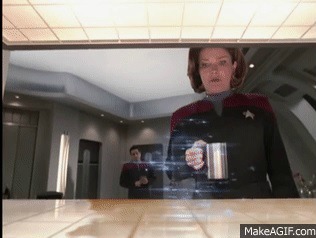
Now let’s jump to current developments with 3D printing or additive manufacturing. This technology is now letting us have first versions of real replicators. My background is firmly rooted in testing, so testing such a machine is on my wish list. Testing a 3D printer may not directly be my first challenge. The commercial 3D printers are widely available, hopefully, they are tested well. Looking at the stuff that comes out of the printer sparked my interest. Material properties of 3D printed structures like strength or temperature distribution are different compared to other manufacturing methods.
Last week a colleague presented me with the top 10 challenges and the top 10 principles regarding 3D printing. He also wrote a nice blog about this on LinkedIn . Let’s look at these lists:
10 Principles of 3D printing ( BigThink ):
Principle one: Manufacturing complexity is free
Principle two: Variety is free
Principle three: No assembly required
Principle four: Zero lead time
Principle five: Unlimited design space
Principle six: Zero skill manufacturing
Principle seven: Compact, portable manufacturing
Principle eight: Less waste by-product
Principle nine: Infinite shades of materials
Principle ten: Precise physical replication
10 Challenges of 3D printing the Media doesn’t tell you about ( Posted by THEFULLAPPLE )
- It’s damn difficult to get right
- Scott Crump’s patent delayed progress by 20 years
- The 3D Printing market is two faced
- They’re still pretty expensive
- You need some amount of technical know how
- A watched model never prints…
- Quality, not quantity – or neither?
- Life support
- Material world
- A perfect end to a non-perfect print
Considering these lists, I see huge possibilities for 3D printing with a considerable way to go where technology is concerned. The ideas and potential savings in money, speed (time to market) and tech are very promising. The simple and quick output of a replicator is still some time away. Research-wise, all technology is there. To get this into commercial shape or eventually in our homes is the step to look at.
Now we know we can print everything (in the near future at least!). The future possibilities are endless. Looking at future scenarios for 3D printing we can combine those to see that replicators can help repairing human bodies. Let’s combine future scenario’s like the self-healing vehicle with printing complex organs: Not only prosthetics but any damage to the body from a simple cut to fractures or sick organs can be automatically fixed!
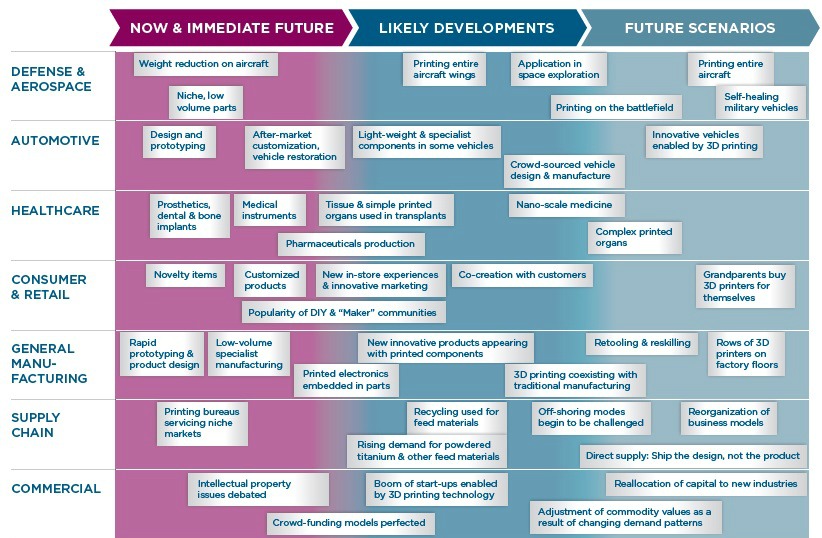
Ok, this is all considering the future. Let’s take a moment to see what is happening now and what is needed to make the replicator become a reality. Current 3D printers print what we tell them to. The result is hopefully something resembling what you have designed. What we do not know is how good the printed result is. The strength, temperature distribution and stress points, for example, may differ from what we would expect with conventional manufacturing methods. Before 3D printing is going to make a flight, we must know the behavior of these properties when 3D printing.
Testing 3D printed structures is an activity not to be underestimated. Of course, testing after printing can be done. It takes considerable time to print, therefore if we know more about 3D printed material behavior before it is printed, this is very helpful. A 3D print goes through different phases (from idea to design to actual (multiple versions of) prints). Testing in each phase helps to get the product (first time) right and at a quality level that is expected. Setting up testing for additive manufacturing can be an extension for TMap . The base TMap gives us can be reused and the phases for 3D printing can be added.
By putting 3D print test activities to each phase, a rudimentary additive manufacturing test strategy is here:
- Design and test your design, review for testability
- Simulate design for printing and test if the design can be made
- Simulate printed product properties (FEA on temperature distribution, stress)
- Print! (Test layers during printing, fill any gaps found)
- Physical test the printed product on product properties (compare with other production methods)

Testing the star trek replicator is not about testing the machine itself but about testing its output. Let’s finish off with two things that I think are worth thinking about where 3D print test activities are concerned:
- What kind of prints do we need to run through the replicator to test that the replicator replicates? Eventually, it should be possible to replicate a replicator.
- How do we make sure no flaws come into next generations of replicators? Almost like new populations where genes are given through and a tiny gene alteration is of massive impact to next generations (of prints in this case).
There are is great stuff going on in the world of additive manufacturing. With the Star Trek replicator well on its way, additive manufacturing testing is crucial!
About the author

Related posts
The relevance of coe testing in a modern, agile organization, the evolution of software performance experts: from testers to sres, think before you automate, how performance testing could improve your organization’s sustainability, can robots do better testing than human, metrics, measurement and monitoring: how qe&t can contribute to sustainable it, capitalise on the current; invest in the future, resilience in the line of chaos, aftermovie executive summit '23 – scarcity in abundance, an example for testers, leave a reply cancel reply.
Your email address will not be published. Required fields are marked *
Save my name, email, and website in this browser for the next time I comment.
Slide to submit
The Replicator: Maybe You Can Have Everything
- First Online: 25 August 2016
Cite this chapter

- Mark E. Lasbury 2
747 Accesses
Star Trek represents a post-scarcity society in which all material needs are met through the use of the replicator. Raw materials at the atomic level are manipulated in a bottom-up manner to build whatever object is needed, in real time. This may seem like science fiction, but research is bringing manufacture on a molecular scale closer every day. 3D printing has developed to the point that simple objects can be made at home for only a few dollars, but the technologies have moved well beyond 3D printing of plastics or metal. 4D techniques that allow for products that respond to environmental changes are moving into the marketplace, as are printed foods and biological tissues and organs. Beyond these technologies lies true molecular manufacturing wherein nanotools or nanobots produce themselves and manipulate raw materials in order to build products one atom at a time. Already there are wrenches, motors, and light-powered submarines being produced that consist of only a few atoms, but are powerful enough do work on small molecules or individual atoms.
The replicators on decks four through nine are producing nothing but cat food. —Commander Riker TNG: A Fistful of Datas
This is a preview of subscription content, log in via an institution to check access.
Access this chapter
Subscribe and save.
- Get 10 units per month
- Download Article/Chapter or Ebook
- 1 Unit = 1 Article or 1 Chapter
- Cancel anytime
- Available as PDF
- Read on any device
- Instant download
- Own it forever
- Available as EPUB and PDF
- Compact, lightweight edition
- Dispatched in 3 to 5 business days
- Free shipping worldwide - see info
Tax calculation will be finalised at checkout
Purchases are for personal use only
Institutional subscriptions
SE Bakarich, R Gorkin, M in het Panhuis, and GM Spinks. 4D Printing with Mechanically Robust, Thermally Actuating Hydrogels. Macromolecular Rapid Communications 36(12); 1211-1217, 2015. doi: 10.1002/marc.201500079 . http://www.sciencedaily.com/releases/2015/04/150423213500.htm
LE Bertassoni, M Cecconi, V Manoharan, J Hjortnaes, AL Cristino, G Barabaschi, D Demarchi, MR Dokmeci, Y Yang, and A Khademhosseini. Hydrogel bioprinted microchannel networks for vascularization of tissue engineering constructs. Lab Chip 14(13): 2202-2211, 2014. doi: 10.1039/c4Ic00030g . http://pubs.rsc.org/en/Content/ArticleLanding/2014/LC/C4LC00030G#!divAbstract
L Bindi, P Steinhardt, N Yao, and P Lu. Natural quasicrystals. Science 324(5932): 1306-1309, 2009. doi: 10.1126/science.1170827 . http://science.sciencemag.org/content/324/5932/1306.abstract
L Bindi, N Yao, C Lin, LS Hollister, CL Andronicos, VV Distler, MP Eddy, A Kosin, V Kryachko, GJ MacPherson, WM Steinhardt, M Yudoskaya, and PJ Steinhardt. Natural quasicrystal with decagonal symmetry. Scientific Reports 5; 9111, 2015. doi: 10.1038/srep09111 . http://www.nature.com/articles/srep09111
M Bobnar, P Jeglic, M Klanjsek, Z Jaglicic, M Wencka, P Popcevic, J Ivkov, D Stanic, A Smontara, P Gille, and J Dolinsek. Intrinsic anisotropic magnetic, electrical, and thermal transport porperties of d -Al-Co-Ni decagonal quasicrystals. Physcial Review B 85(2); 024205, 2012. doi: 10.1103/PhysRevB.85.02.024205 . http://journals.aps.org/prb/abstract/10.1103/PhysRevB.85.024205
WR Browne, and BL Feringa. Making molecular machines work. Nature Nanotechnology 1; 25-35, 2006. doi: 10.1038/nnano.2006.45 . http://www.nature.com/nnano/journal/v1/n1/full/nnano.2006.45.html
O Custance, R Perez, and S Morita. Atomic force microscopy as a tool for atom manipulation. Nature Nanotechnology 4; 803-810, 2009. doi: 10.1038/nnano.2009.347 . http://www.nature.com/nnano/journal/v4/n12/abs/nnano.2009.347.html
M Fessenden. 3-D printed windpipe gives infant breath of life. Scientific American Online. May 24, 2013. Accessed 09/12/15. http://www.scientificamerican.com/article/3-d-printed-windpipe/
R Feynman. There’s plenty of room at the bottom. Caltech Engineering and Science 23(5): 22-36, 1960. http://www.zyvex.com/nanotech/feynman.html
JE Fischer. Storing energy in carbon nanotubes. Chemical Innovation 30(10); 21-27, 2000. http://pubs.acs.org/subscribe/archive/ci/30/i10/html/10fischer.html
TC Fitzgibbons, M Guthrie, E Xu, VH Crespi, SK Davidowski, GD Cody, N Alem, and JV Badding. Benzene-derived carbon nanothreads. Nature Materials 14; 43-47, 2015. doi: 10.1038/nmat4088 . http://www.nature.com/nmat/journal/v14/n1/full/nmat4088.html
T Frey. The coming food printer revolution. FuturistSpeaker Blog, October, 17 2011. Accessed November 20, 2015. http://www.futuristspeaker.com/2011/10/the-coming-food-printer-revolution/
V García-López, PT Chiang, F Chen, G Ruan, AA Martí, AB Kolomeisky, G Wang, and JM Tour. Unimolecular Submersible Nanomachines. Synthesis, Actuation, and Monitoring. Nano Letters . November 5, 2015. Epub ahead of print doi: 10.1021/acs.nanolett.5b03764 . http://pubs.acs.org/doi/abs/10.1021/acs.nanolett.5b03764
Q Ge, HJ Qi, and ML Dunn. Active Materials by four-dimension printing. Applied Physics Letters 103; 131901, 2013. doi: 10.1063/1.4819837 . http://scitation.aip.org/content/aip/journal/apl/103/13/10.1063/1.4819837
TJ Hinton, Q Jallerat, RN Palchesko, JH Park, MS Grodzicki, HJ Shie, MH Ramadan, AR Hudson, and AW Feinberg. Three-dimensional printing of complex biological structures by freeform reversible embedding of suspended hydrogels. Sci Adv 1(9); e1500758, 2015. doi: 10.1126/sciadv.1500758 . http://advances.sciencemag.org/content/1/9/e1500758
Z Izadifar, T Chang, AM Kulyk, D Chen, and BF Eames. Analyzing biologicalperformance of 3D-printed, cell-impregnated hybrid constructs for cartilage tissue engineering. Tissue Eng Part C Methods Nov. 23, 2015 (Epub ahead of print) doi: 10.1089/ten.TEC.2015.0307 . http://online.liebertpub.com/doi/abs/10.1089/ten.TEC.2015.0307
S Jesse, Q He, AR Lupini, DN Leonard, MP Oxley, O Ovchinnikov, RR Unocic, A Tselev, M Fuentes-Cabrera, BG Sumpter, SJ Pennycook, SV Kalinin, and AY Borisevich. Atomic-Level Sculpting of Crystalline Oxides: Toward Bulk Nanofabrication with Single Atomic Plane Precision. Small 11(44); 5895-5900, 2015. doi: 10.1002/smll.201502048 . http://onlinelibrary.wiley.com/doi/10.1002/smll.201502048/abstract
H-W Kang, SJ Lee, IK Ko, C Kengla, JJ Yoo, and A Atala. A 3D bioprinting system to produce human-scale tissue constructs with structural integrity. Nature Biotechnology Published online February 15, 2016. doi: 10.1038/nbt.3413 . http://www.nature.com/nbt/journal/vaop/ncurrent/full/nbt.3413.html
S Kawai, AS Foster, FF Canova, H Onodera, S Kitamura, and E Meyer. Atom manipulation on an insulating surface at room temperature. Nature Communications 5; 4403, 2014. doi: 10.1038/ncomms5403 . http://www.nature.com/ncomms/2014/140715/ncomms5403/full/ncomms5403.html
DB Kolesky, RL Truby, AS Gladman, TA Busbee, KA Homan, and JA Lewis. 3D bioprinting of vascularized, heterogeneous cell-laden tissue constructs. Adv Mater 26(19); 3124-3130, 2014. doi: 10.1002/adma.201305506 . http://onlinelibrary.wiley.com/doi/10.1002/adma.201305506/abstract;jsessionid=569053B40DB17B11847A93900790129D.f02t03
A Koptyug, LE Rannar, M Backstrom, and R Langlet. Bulk metallic glass manufacturing using electron beam melting. In: Proceedings from Additive Manufacturing & 3D Printing , Nottingham, UK, July 2013, Nottingham, UK, 2013.
Google Scholar
T Kudernac, N Ruangsupapichat, M Parschau, B Maciá, N Katsonis, SR Harutyunyan, KH Ernst, and BL Feringa. Electrically driven directional motion of a four-wheeled molecule on a metal surface. Nature 479 (7372); 208, 2011. doi: 10.1038/nature10587 . http://www.nature.com/nature/journal/v479/n7372/full/nature10587.html
M Liu, VI Artyukhov, H Lee, F Xu, and BI Yakobson. Carbyne From First Principles: Chain of C atoms, a Nanorod or a Nanorope. ACS Nano 7(11); 10075 – 10082, 2013. doi: 10.1021/nn404177r . http://pubs.acs.org/doi/abs/10.1021/nn404177r
X Liu, ZJ Weinert, M Sharafi, C Liao, J Li, and ST Schneebeli. Regulating Molecular Recognition with C-Shaped Strips Attained by Chirality-Assisted Synthesis. Angewandte Chemie International Edition , 54(43); 12772-12776, 2015. doi: 10.1002/anie.201506793 . http://onlinelibrary.wiley.com/doi/10.1002/anie.201506793/abstract
ZP, Lu, CT Liu, JR Thompson, and WD Porter. Structural amorphous steels. Physical Review Letters 92; 245503, 2004. doi: 10.1103/PhysRevLett.92.245503 . http://journals.aps.org/prl/abstract/10.1103/PhysRevLett.92.245503
JF Morin, Y Shiarai, and JM Tour. En route to a motorized nanocar. Org Lett . 8(8); 1713-6, 2006. doi: 10.1021/ol060445d . http://pubs.acs.org/doi/abs/10.1021/ol060445d
D Oberhaus. Quasicrystals are nature’s impossible matter. Motherboard May 3, 2015. Accessed 11/04/15. http://motherboard.vice.com/read/quasicrystals-are-natures-impossible-matter
J Paek, I Cho, and J Kim. Microrobotic tentacles with spiral bending capability based on shape-engineered elastomeric microtubes. Scientific Reports , 5; 10768, 2015. doi: 10.1038/srep10768 . http://www.nature.com/articles/srep10768
K Pearson. Voice recognition search engine connected to 3D printer by Yahoo! Japan. MakerFlux, The Open Maker Community , September 19, 2013. Accessed 10/14/15. http://makerflux.com/voice-recognition-search-engine-connected-to-3d-printer-by-yahoo-japan/
Z Peng, J Lin, R Ye, ELG Samuel, and JM Tour. Flexible and stackable laser induced graphene supercapacitors. Applied Materials and Interfaces 7(5); 3414-3419, 2015a. doi: 10.1021/am509065d . http://pubs.acs.org/doi/abs/10.1021/am509065d
Z Peng, J Lin, R Ye, JA Mann, D Zakhidov, Y Li, PR Smalley, J Lin, and JM Tour. Flexible boron-doped laser-induced graphene microsupercapacitors. ACS Nano 9(6); 5868-5875, 2015b. http://pubs.acs.org/doi/abs/10.1021/acsnano.5b00436
M Schroeder. Fractals, Chaos, Power Laws: Minutes from an Infinite Paradise . New York: WH Freeman, 1991.
BH Shin, SM Felton, MT Tolley, and RJ Wood. Self-Assembling Sensors for Printable Machines. IEEE International Conference on Robotics and Automation (ICRA) , Hong Kong, China, May 31 – June 7, 2014. https://micro.seas.harvard.edu/papers/ICRA14_Shin.pdf
Y Shirai, AJ Osgood, Y Zhao, KF Kelly, and JM Tour. Directional control in thermally driven single-molecule nanocars. Nano Lett 5(11); 2330-4, 2005. doi: 10.1021/nl051915k . http://pubs.acs.org/doi/abs/10.1021/nl051915k
JA Stroscio, F Tavazza, JA Crain, RJ Celotta, and AM Chaka. Electronically induced atom motion in engineered CoCu nanostructures. Science 313 (5789); 948-951, 2006. doi: 10.1126/science.1129788 . http://science.sciencemag.org/content/313/5789/948
N Sugiyama, HY Xu, T Onoki, Y Hoshikawa, T Watanabe, N Matsushita, X Wang, FX Qin, M Fukuhara, M Tsukamoto, N Abe, Y Komizo, A Inoue, and M Yoshimura. Biocative titante nanomesh layer on Ti-based bulk metallic glass by hydrothermal-electrochemical technique. Acta Biomaterialia 5(4); 1367-1373, 2009. doi: 10.1016/j.actbio.2008.10.014 . http://europepmc.org/abstract/MED/19022712
I Williams, EC Oğuz, T Speck, P Bartlett, H Löwen, and CP Royall. Transmission of torque at the nanoscale. Nature Physics 12; 98-103, 2016. doi: 10.1038/nphys3490 . http://www.nature.com/nphys/journal/v12/n1/full/nphys3490.html
R Ye, Z Peng, T Wang, Y Xu, J Zhang, Y Li, LG Nilewski, J Lin, and JM Tour. In situ formation of metal oxide nanocrystals embedded in laser-induced graphene. ACS Nano 9(9); 9244-9251, 2015. doi: 10.1021/acsnano.5b04138 . http://pubs.acs.org/doi/abs/10.1021/acsnano.5b04138?journalCode=ancac3
L Zhang, X Wang, W Xu, Y Zhang, Q Li, PD Bradford, and Y Zhu. Strong and Conductive Dry Carbon Nanotube Films by Microcombing. Small , 11(31); 3830-3836, 2015. doi: 10.1002/smll.201500111 . http://onlinelibrary.wiley.com/doi/10.1002/smll.201500111/abstract
DA Zopf, SJ Hollister, ME Nelson, RG Ohye, and GE Green. Bioresorbable airway splint created with a three-dimensional printer. New Engl J Med 368; 2043-2045, 2013. doi: 10.1056/NEJMx1206319 . http://www.nejm.org/doi/full/10.1056/NEJMc1206319
Online Material
Made In Space Press Release, August 10, 2015. http://www.madeinspace.us/made-in-space-announces-in-vacuum-additive-manufacturing-breakthrough/
NASA Press release, November, 25, 2014. https://www.nasa.gov/content/open-for-business-3-d-printer-creates-first-object-in-space-on-international-space-station
NASA Press release, August 27, 2015. http://www.nasa.gov/press/2013/august/nasa-tests-limits-of-3-d-printing-with-powerful-rocket-engine-check/#.Vl0NWWSrSmM
Science Daily summary from ESA, June, 25, 2014. http://www.sciencedaily.com/releases/2014/06/140625133309.htm
Ray Kurzweils’ talk at Google I/O 2014. https://www.google.com/events/io/io14videos/4bdebcad-11da-e311-b297-00155d5066d7
Download references
Author information
Authors and affiliations.
Indianapolis, IN, USA
Mark E. Lasbury
You can also search for this author in PubMed Google Scholar
Corresponding author
Correspondence to Mark E. Lasbury .
Rights and permissions
Reprints and permissions
Copyright information
© 2017 Springer International Publishing Switzerland
About this chapter
Lasbury, M.E. (2017). The Replicator: Maybe You Can Have Everything. In: The Realization of Star Trek Technologies. Springer, Cham. https://doi.org/10.1007/978-3-319-40914-6_3
Download citation
DOI : https://doi.org/10.1007/978-3-319-40914-6_3
Published : 25 August 2016
Publisher Name : Springer, Cham
Print ISBN : 978-3-319-40912-2
Online ISBN : 978-3-319-40914-6
eBook Packages : History History (R0)
Share this chapter
Anyone you share the following link with will be able to read this content:
Sorry, a shareable link is not currently available for this article.
Provided by the Springer Nature SharedIt content-sharing initiative
- Publish with us
Policies and ethics
- Find a journal
- Track your research
Screen Rant
“errand of mercy”: star trek’s first klingon episode explained.

Your changes have been saved
Email Is sent
Please verify your email address.
You’ve reached your account maximum for followed topics.
Star Trek’s 10 Greatest Klingons
Every version of the klingons in star trek, the bear season 3 completely reverses my favorite episode of the entire show (& i’m devastated).
- Klingons debuted in Star Trek: TOS' "Errand of Mercy," setting the stage for their future appearances.
- Klingons were initially ruthless villains, but evolved into a species with honor and tradition.
- Klingon appearance and culture have undergone numerous updates since their introduction, with Star Trek: Discovery introducing a controversial new look.
The Star Trek: The Original Series episode, "Errand of Mercy" includes the first appearance of one of Star Trek 's most iconic aliens — the Klingons. Throughout its three seasons, TOS produced some truly memorable episodes of television, many of which continue to affect the Star Trek franchise today. The adventures of Captain James T. Kirk (William Shatner) and the USS Enterprise crew laid the groundwork for every Star Trek story that came after. Many of the franchise's most recognizable aliens made their debut on TOS, including the infamous Klingons.
Star Trek: The Original Series season 1, episode 26, "Errand of Mercy," sends Captain Kirk and his crew to the planet Organia, as they try to convince the locals to side with the United Federation of Planets rather than the Klingons. As Kirk and Mr. Spock (Leonard Nimoy) speak with the Organians, Klingon forces arrive, forcing the Enterprise to retreat to a safe distance. Kirk then faces off against the Klingon leader Kor (John Colicos), who proves to be an intelligent military strategist. Although the appearance and culture of the Klingons would change a lot over the years, their depiction in "Errand of Mercy" set up everything that came after.
Star Trek has many great Klingon characters from Kor to Worf and Kruge to Torres. But who are the best Klingon warriors that Qo'noS has to offer?
What Happened In Star Trek: The Original Series' “Errand of Mercy”
Captain kirk met the organians & the klingons for the first time..
In Star Trek: The Original Series ' "Errand of Mercy," the United Federation of Planets is on the brink of war with the Klingon Empire, so Captain Kirk and the USS Enterprise are sent to Organia, a planet that sits on the Federation/Klingon border. The Federation hopes to prevent the Klingons from taking advantage of Organia's strategic location. Kirk and Spock beam down to the planet, initially believing it won't be difficult to convince the Organians to work with the Federation. The local council leader, a man named Ayelborne (John Abbott), insists that they want no part in any conflict and refuses to take part in any kind of violence.
Soon, a Klingon fleet appears in orbit around Organia, forcing the Enterprise to retreat and leave Kirk and Spock on the planet. The Organians do not make any attempt to resist the Klingons, who quickly take control of the planet, led by Commander Kor. Attempting to inspire the Organians to fight back, Kirk and Spock sabotage the Klingon's supplies. When Kor tries to torture Kirk and Spock for information, the Organians put a stop to the conflict, revealing their true nature as powerful, non-corporeal beings.
Klingons Debuted In Star Trek: The Orginal Series’ “Errand of Mercy”
John colicos' kor remains one of star trek's most important klingons..
John Colicos' Kor made quite an impression as one of the first Klingons to appear on screen, and his performance helped establish the personality of many Klingons moving forward. As Kirk describes the Klingons, they are presented as a "military dictatorship" whose civilization is constantly at war with some foe or another. When Kor arrives on Organia, he immediately declares its people to be "subjects of the Klingon Empire" and enacts a series of laws punishable by death. The Klingons in "Errand of Mercy" are ruthless villains built on outdated stereotypes, but they gained more nuance and characterization in later appearances.
As the writer of "Errand of Mercy," Gene L. Coon is credited with the creation of the Klingons, although actor John Colicos helped create their distinctive look.
Kor goes toe-to-toe with Captain Kirk, and while he displays a certain level of honor in his dealings, the Klingons of Star Trek: TOS were not known for their honor. Not only do the Klingons subjugate the Organians and order mass executions, but they also try to torture Kirk and Spock for information. The Klingons are depicted as savage conquerors, with little patience for other cultures. As the Organians predicted, however, the Klingons and the Federation would eventually become allies, and while the Klingons remained fierce warriors, they toned down their ruthlessness a bit.
The Klingons are one of the most diverse alien species in all of Star Trek, and multiple different variations have appeared in canon from TOS onward.
How Klingons Have Changed Since Star Trek: The Original Series’ “Errand of Mercy”
The appearance and culture of the klingons have received numerous updates over the years..
In both appearance and culture, the Klingons have changed a great deal since their introduction in "Errand of Mercy." Star Trek: The Original Series was limited regarding budget and make-up, and it wasn't until Star Trek: The Motion Picture that the look of the Klingons got an upgrade. With longer hair and the now-iconic forehead ridges, Star Trek: The Motion Picture brought the Klingons closer to their most recognizable look. Star Trek: The Next Generation solidified this look, and dove deeper into Klingon culture and tradition with Lt. Worf (Michael Dorn).
John Colicos returned as Kor in three episodes of Star Trek: Deep Space Nine , with the upgraded look of TNG -era Klingons.
Star Trek: Deep Space Nine continued Worf's exploration of his Klingon heritage, further establishing the honor and tradition at the heart of Klingon society. Like any species, however, not all Klingons upheld this ideal version of their culture. Star Trek: Discovery introduced Klingons of a very different sort, with a controversial new look. Since their introduction in Star Trek: The Original Series , the Klingons have changed perhaps more than any other Star Trek species, but they remain one of the most recognizable fictional species in popular culture.
Star Trek: The Original Series
*Availability in US
Not available
Star Trek: The Original Series follows the exploits of the crew of the USS Enterprise. On a five-year mission to explore uncharted space, Captain James T. Kirk (William Shatner) must trust his crew - Spock (Leonard Nimoy), Dr. Leonard "Bones" McCoy (Forest DeKelley), Montgomery "Scotty" Scott (James Doohan), Uhura (Nichelle Nichols), Chekov (Walter Koenig) and Sulu (George Takei) - with his life. Facing previously undiscovered life forms and civilizations and representing humanity among the stars on behalf of Starfleet and the United Federation of Planets, the Enterprise regularly comes up against impossible odds and diplomatic dilemmas.
Mark Cavendish claims record-breaking 35th career Tour de France stage win

SAINT-VULBAS, France — Mark Cavendish wrote a new chapter of Tour de France history in what is expected to be his last appearance at cycling’s biggest race.
The veteran Isle of Man sprinter broke Eddy Merckx’s long-standing record for most career Tour de France stage wins with his 35th victory on Wednesday.
The 39-year-old Cavendish sprinted for the win in the fifth stage of the Tour, pulling away some 100 meters from the line despite being bunched in. He crossed the line ahead of Jasper Philipsen and then celebrated with teammates.
Norwegian rider Alexander Kristoff, who had crashed earlier, finished third. They were given the same time of 4 hours, 8 minutes, 46 seconds.
Sixteen years after his first Tour stage win, Cavendish spoke of his constant hunger for victory.
“I always needed to win one more,” said Cavendish, who was joined by his children on the podium. “It takes a lot to get there every year. I’ve got incredible people around me.”
Two-time champion Tadej Pogacar narrowly avoided a crash and finished nestled in the main pack in 35th place. While Pogacar retained the race leader’s yellow jersey, the day belonged to Cavendish.
He equaled Merckx’s mark of 34 wins during the 2021 Tour and went close to No. 35 in the seventh stage last year when he was narrowly beaten by Philipsen. He crashed a day later and broke his right collarbone.
Merckx, the Belgian considered the most dominant rider in cycling history, won his 34 individual stages at the Tour from 1969-75.
Cavendish’s decision to give it one more shot paid off.
“I just wanted to get the run-in to do it. I’m a little bit in disbelief. Astana put a big gamble on this year to make sure we’re good at the Tour de France,” Cavendish said. “We’ve done it.”
With his 2023 race ending early, Cavendish decided to put off retirement by a year and came back to try again.
Finally, Cavendish made cycling history, after winning his first Tour stage back in 2008.
Other riders were happy for Cavendish, with several stopping to speak with or hug him after the 177.4-kilometer (110-mile) leg from Saint-Jean-De-Maurienne to Saint-Vulbas
Merckx amassed his wins in an era during which his domination was such that he earned the nickname “The Cannibal.” Unlike Merckx, one of four riders to win the Tour five times, Cavendish has never won the overall title, or come close.
But Cavendish’s longevity among his fellow Tour sprinters has no equal.
He won the Tour de France best sprinter’s green jersey twice. He also won stages at all three Grand Tours — the others are the Giro d’Italia and Spanish Vuelta — and became a world champion in 2011.
Cavendish joined Astana after his contract with Quick-Step Alpha Vinyl expired and he was overlooked for the 2022 Tour.
Cavendish had faced a difficult start to this Tour. During the first stage, he appeared to struggle with stomach and heat issues.
“I know how it works, my trainer and everyone around me knows how it is,” Cavendish said. “I’ve done 15 Tours de France. I don’t like to have bad days, I don’t like to suffer but I know it’s just in the head and to push through it.”
More from Sports
- Simone Biles leads the most experienced U.S. women's gymnastics team ever into the Olympics
- Caitlin Clark and Angel Reese to team up on WNBA All-Star team that will face Olympic squad
- Bronny James says he can handle 'amplified' pressure of playing for Lakers with his famous father
Meanwhile, Pogacar has another flat stage to get through safely Thursday, having reclaimed the leader’s jersey Tuesday with a brilliant attack near the top of the race’s first big mountain pass.
On Wednesday, he was simply relieved to avoid crashing.
“We were in the bunch and then suddenly something came up in the middle from nowhere. The guys in front of me braked and we touched wheels a little bit, but luckily I escaped,” he said. “I reacted on instinct and was very lucky.”
The 25-year-old Slovenian leads overall by 45 seconds from Tour debutant Remco Evenepoel, the Vuelta and world champion in 2022. Pogacar is 50 seconds ahead of two-time defending champion Jonas Vingegaard — the Danish rider who was badly injured in a high-speed crash at the Tour of Basque Country in early April.
Pogacar is aiming for the rare Giro-Tour double, and for his third Tour title after wins in 2020 and 2021. The last rider to win the Giro and the Tour the same year was the late Marco Pantani in 1998.
Wednesday’s stage saw Clement Russo and Matteo Vercher forming a breakaway after 35 kilometers (22 miles).
Given that French riders won the first two stages through Romain Bardet and Kevin Vauquelin , this may have motivated them. With rain falling, Russo and Vercher were caught with 36 kilometers (22 miles) left.
Stage 6 on Thursday is again suited for sprinters, going through vineyards to Dijon on a mainly flat trek of around 100 miles. The first individual time trial is on Friday.
The Associated Press
Follow Polygon online:
- Follow Polygon on Facebook
- Follow Polygon on Youtube
- Follow Polygon on Instagram
Site search
- How to access the DLC
- What to do first
- Interactive map
- Walkthrough
- Scadutree Fragments
- Erdtree map fragments
- Boss locations
- Hornsent questline
- Sir Ansbach questline
- All DLC guides
- Elden Ring DLC
- Zelda: Tears of the Kingdom
- Baldur’s Gate 3
- Elden Ring endings
- PlayStation
- Dungeons & Dragons
- Magic: The Gathering
- Board Games
- All Tabletop
- All Entertainment
- What to Watch
- What to Play
- Buyer’s Guides
- Really Bad Chess
- All Puzzles
Filed under:
- Entertainment
Star Trek: Prodigy season 2, Tower of God season 2, and more new TV this week
Plus: Nier, Hard Knocks Offseason, and more
Share this story
- Share this on Facebook
- Share this on Reddit
- Share All sharing options
Share All sharing options for: Star Trek: Prodigy season 2, Tower of God season 2, and more new TV this week
/cdn.vox-cdn.com/uploads/chorus_image/image/73438321/Screenshot_2024_06_27_at_11.33.55.0.png)
If you’re in the States, then this week is July Fourth. If you’re not in the States, then this week is just July 4 — congrats to all who get to mark the day however they are, wherever they are! No surprise, but: I think we should all celebrate by watching TV. Particularly if you’re in for anime, there’s a lot of premieres this week on Crunchyroll, meaning you can roll right through the long (or regular!) weekend with a blitz of new programs.
Here’s the best new TV premieres (and just a few of the anime previews) this week.
New shows on Netflix
Star trek: prodigy.
Genre: Star Trek (animated YA adventures edition) Release date: July 1, with all episodes Showrunner/creator: Kevin and Dan Hageman Cast: Brett Gray, Ella Purnell, Jason Mantzoukas, and more
Prodigy has survived cancellation (read: was in production for season 2 when it got axed by Paramount) and has jumped over to a new network (read: was subsequently picked up by Netflix). That means that if you liked what Prodigy was putting down in season 1, you will probably like it when it makes its way to Netflix.
New shows on Max
Hard knocks: offseason with the new york giants.
Genre: Docuseries, sports drama Release date: July 2 Cast: The players and staff of the New York Giants
The New York Giants are entering their 100th season. It’s quite an accomplishment, but they (like all NFL teams) won’t settle for anything less than a Super Bowl slot. Will they get it? Who’s to say — but now we can at least watch what they’re saying during the offseason.
New shows on Crunchyroll
Nier: automata ver1.1a season 2.
Genre: Sci-fi action Release date: July 5, with one episode Studio: A-1 Pictures
Fans of the Nier: Automata , rejoice: The gorgeous anime adaptation of the hit game is finally making its return this summer with a second season following the first’s protracted and troubled development. Hopefully A-1 Pictures has ironed out all the details for this new season so we won’t be waiting weeks or even months between episodes.
The second “cour” (the term for a production block of anime averaging between 10 and 14 episodes) will pick up immediately after the first, with 9S having learned the shocking truth behind Project YoRHa after defeating the alien robots Adam and Eve alongside 2B. We’ll have to wait until July 5 to see just how much Nier: Automata Ver1.1a will diverge from the story of the original game. —Toussaint Egan
Tower of God season 2
Genre: Fantasy action Release date: July 7, with one episode Studio: The Answer Studio
There’s a (in-universe) six-year gap between seasons here, and while we’ll be following up with Bam, Rachel, and the rest of the season 1 crew — along with their rankings! — season 2 is also bringing in some new protagonists. Meet Wangnan and Jyu, who are a little more advanced in the tower’s levels than we’ve seen so far. Time to find out what new challenges this mysterious tower can bring!
My Deer Friend Nokotan
Genre: Slice-of-life comedy Release date: July 7, with one episode Studio: Wit Studio
Based on the 2019 manga by Oshioshio, My Deer Friend Nokotan is a comedy that centers on the misadventures of Torako Koshi, a former “yankee” (see: delinquent) girl trying to keep up her appearance as a ideal student at her new high school. That becomes significantly more difficult after she saves Noko Shikanoko, a self-described “deer-girl hybrid” who begins to follow Torako around and get up to all sorts of shenanigans.
The trailer looks ridiculous, with realistic CG depictions of deer juxtaposed with Noko’s chibi-like appearance. There’s even a cute callback to the ending of 1984’s Nausicaä of the Valley of the Wind , with Noko being lifted above a marching herd of deer while surrounded by an aura of light. We’ll see how the actual series holds up when it premieres this weekend. —TE
Wistoria: Wand and Sword
Genre: Fantasy action Release date: July 7, with one episode Studio: Actas, Bandai Namco Pictures
Based on the fantasy adventure manga by author Fujino Ōmori and illustrator Toshi Aoi, Wistoria: Wand and Sword centers on Will Serfort, a young student who enrolls at a prestigious magic academy with hopes of achieving his dream of becoming one of the most powerful magic users in the world. However, much like My Hero Academia ’s Izuku Midoriya or Solo Leveling ’s Sung Jin-woo, Will has a critical roadblock: He can’t cast even the simplest of spells to save his own life!
That’s not gonna stop him, though, as he descends into the dungeons beneath the school to slay vicious monsters as an alternate way to earn academic credits. He’s like Naruto ’s Rock Lee, only instead of being terrifyingly proficient in taijutsu, he’s an absolute beast when it comes to sword fighting.
I’m not familiar with the source material myself, but I am intrigued by the fact that Tatsuya Yoshihara, who previously worked as the action director on 2022’s Chainsaw Man and the chief director on the final season of Black Clover , is the director on Wistoria: Wand and Sword . Which means, at the very least, audiences can expect some exquisite action sequences. —TE
The next level of puzzles.
Take a break from your day by playing a puzzle or two! We’ve got SpellTower, Typeshift, crosswords, and more.
Sign up for the newsletter Shopkeeper
We deliver the best gaming deals to your inbox for the perfect price: free
Just one more thing!
Please check your email to find a confirmation email, and follow the steps to confirm your humanity.
Oops. Something went wrong. Please enter a valid email and try again.
Loading comments...

Inside Out 2 has besmirched my favorite vegetable and I will not stand for it

Shadows of the Galaxy is the first expansion for Star Wars: Unlimited, here’s where to pre-order

Netflix’s final season of Vikings: Valhalla and more new TV to watch this week

Pokémon Go ‘Inbound from Ultra Space’ event, Timed Research guide

Agatha All Along brings a whole coven of witches (and one demiurge) to the MCU

Some of our favorite keyboards are on sale at Woot

An inactive Federation holodeck, pre- 2371
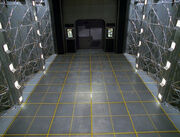
An inactive Federation holodeck, post- 2371
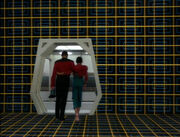
An alternate holodeck design
A holographic environment simulator , or holodeck as it was most commonly referred to, was a holographic simulation room , which was a form of holotechnology designed and used by the Federation Starfleet which ran holographic programs . They were installed aboard starships , space stations , and at Starfleet institutions during the mid- 24th century for use in entertainment, training, and investigative purposes. ( TNG : " Encounter at Farpoint ")
- 4 Abilities and limitations
- 5 Holoprograms
- 6.1 Appearances
- 6.2 Additional references
- 6.3 Background information
- 6.4 See also
- 6.5 External links
History [ ]
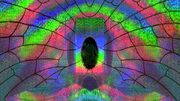
A 22nd century Xyrillian holo-chamber

Captain Lorca and Lieutenant Tyler exiting a holographic combat simulation
Prior to the late 24th century , Federation starships were not equipped with holodecks. ( VOY : " Flashback ")
In 2151 , the Starfleet vessel Enterprise NX-01 encountered a vessel belonging to an alien race known as Xyrillians , who had advanced holographic technology in the form of a holographic chamber, or holo-chamber for short, which was similar to the holodeck technology commonly used by Starfleet two centuries later. ( ENT : " Unexpected ")
A holo-chamber was later installed aboard a Klingon battle cruiser after an encounter with a Xyrillian vessel discovered " hitchhiking " behind their ship. ( ENT : " Unexpected ")
In the 23rd century , the Crossfield -class vessel USS Discovery was equipped with holographic technology including holographic communications and combat training simulations. ( DIS : " Lethe ")
The recreation room aboard Constitution -class starships employed holographic technology. The USS Enterprise had a recreation room located in Area 39 of the ship. ( TAS : " The Practical Joker ")
By 2364 , the Federation Starfleet was already installing holodecks aboard their vessels. ( TNG : " Encounter at Farpoint ")
During the 2360s and 2370s , a starship could have one or more holodecks depending on the vessel's size or purpose. For example, the compact Defiant -class USS Defiant did not have a holodeck while the larger Galaxy -class USS Enterprise -D had at least seven. ( TNG : " The Perfect Mate ")
In 2366 , Data and Deanna Troi brought Lal to the holodeck in order to choose an appearance. ( TNG : " The Offspring ")
The Intrepid -class USS Voyager had at least two holodecks. The holodecks on Voyager were the only places other than sickbay where The Doctor was able to exist (prior to obtaining his mobile emitter ) after his program was modified by the crew so he wasn't so tightly tied into the sickbay's systems. ( VOY : " Night ", " Heroes and Demons ")
B'Elanna Torres used the Voyager 's holodeck for a holographic orbital skydiving session. ( VOY : " Extreme Risk ")
Prometheus -class starships were equipped with holoemitters on every deck to allow an EMH a higher level of access and free movement around the ship. ( VOY : " Message in a Bottle ")
The USS Dauntless was equipped with holodecks. The status of the holodecks, and other areas, of the ship were reported on the master situation display . ( PRO : " Mindwalk ")
A clear view of the MSD was provided by Dominique Rossier of Wardenlight Studio. [1]
Purpose [ ]
The most obvious function of a holodeck was to provide entertainment and diversion for a starship's crew, as they typically spent months or years on missions. Entertainment could come in many forms, with personnel able to compose their own holo programs. Users could, for example, frequent a bar, become a character in a holo-novel , engage in extreme sports, and date and have sex with holographic characters. ( TNG : " 11001001 ", " The Big Goodbye ", " Elementary, Dear Data ", " A Fistful of Datas ", " The Perfect Mate "; VOY : " The Cloud ", " Blood Fever ", " Homestead ", " Fair Haven ", " Extreme Risk ", " Body and Soul ", " Cathexis ", " Night "; LD : " Moist Vessel ")
A holodeck could be used to create training simulations and exercise environments not otherwise available or safe, including starship battle simulations, physical and combat simulations, the Bridge Officer's Test and the Kobayashi Maru scenario . ( TNG : " Code of Honor ", " Where Silence Has Lease ", " The Emissary ", " New Ground ", " Thine Own Self ", " Firstborn "; VOY : " Learning Curve ", " Extreme Risk ", " The Fight "; LD : " Terminal Provocations "; PRO : " Kobayashi ")
The holodeck (or holographic research lab ) could be used as a laboratory to aid in analysis, such as recreating the scene of a crime or accident to aid in forensic investigations. ( TNG : " A Matter of Perspective "; VOY : " Repression ") They could be used to visualize a 3D scene from alternate data sources for analysis, ( TNG : " Identity Crisis ", " Phantasms "; VOY : " Distant Origin ") or used as a brainstorming tool. ( TNG : " Schisms ", " Booby Trap ", " The Offspring ")
The holodeck could also be used to test a person's beliefs or motives by creating a program to trick them into revealing their actions. ( DS9 : " Inquisition ")
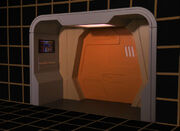
The arch in an inactive holodeck, pre-2371
A typical holodeck consisted of a room equipped with a hologrid containing omnidirectional holographic diodes , enabling holographic projections and holograms . Elements of transporter technology and replicators were used to create holodeck matter by the manipulation of photons contained within force fields to give objects the illusion of substance as well as actual matter. This matter could exist outside of the holodeck for brief periods of time (such as snow) before they would lose cohesion and revert back to energy without the support of the hologrid. ( TNG : " Encounter at Farpoint ", " The Big Goodbye ", " Elementary, Dear Data ") Holodecks were powered by holodeck reactors . ( VOY : " Parallax ") They were also equipped with biofilters which had to be periodically removed and emptied of waste matter. As removing the filter could momentarily expel a cloud of odorous gas, this was generally considered a highly undesirable task. ( LD : " Moist Vessel ")
Holodecks had databases to store programs, holograms, and holographic templates . ( VOY : " Renaissance Man ") A holobuffer stored complex holograms when inactive. ( VOY : " Lifesigns ", " Latent Image ", " Inside Man ") Due to the ability to store highly complex energy patterns, it was possible in some cases to store a person's physical parameters from his or her transporter pattern in the holodeck database. This could, in turn, be available for use in creation of holograms. ( DS9 : " Our Man Bashir ") While viewing programs, a user could delete holocharacters using character deletion algorithms . ( DS9 : " Badda-Bing, Badda-Bang ")
Holodecks had general systems and modes of operation that were used in holographic programs. They employed spatial orientation systems to simulate parts of a holocharacter, such as left- or right-handedness. ( TNG : " Ship In A Bottle ") Holodecks could also have a program element called a perceptual filter to hide anachronisms to the program's time period, such as uniforms and communicators, in order to prevent them from raising the character's ire and curiosity. ( VOY : " Spirit Folk ") Among the viewing modes on a holodeck was objective mode , in which the user didn't interact with the characters, and subjective mode , in which the viewer could interact with the characters as well as alter his or her surroundings. ( ENT : " These Are the Voyages... ") Holodecks could be equipped to change gravity in three dimensions. ( VOY : " Extreme Risk ")
The holodeck could be controlled from an exterior control panel, the interior arch control, or through bridge control relays in some designs. The arch could be summoned at any time to change the parameters of a running holoprogram . Matter and energy were interchangeable as such objects created on the holodeck could be either matter or energy. ( TNG : " Elementary, Dear Data "; VOY : " Heroes and Demons ", " The Killing Game "; Star Trek: Insurrection ) Holodecks included components such as bi-converter interfaces . ( TNG : " The Big Goodbye ")
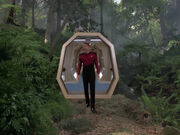
William T. Riker entering a holodeck simulation in 2364
When a user experienced a holographic environment, the holodeck walls could generate holographic images that appeared to extend for an unlimited distance, seemingly much larger than its own dimensions. The walls could be revealed if someone took an unexpected action in the program which hit the wall, for example if a person were to throw a holographic rock at the walls and the program was not able to react to show the rock continuing into the holographic image it created. ( TNG : " Encounter at Farpoint ")
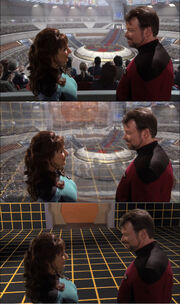
A holodeck program in the process of shutting down
Holodecks were equipped with safety protocols to prevent serious injury during their use, though these could be disengaged by the user when required. When protocols were deactivated, holographic obstacles had the same effects on a person as the objects or instances they simulated; holographic bullets or a steep drop could be fatal in such a scenario. ( TNG : " The Big Goodbye "; Star Trek: First Contact ; VOY : " Extreme Risk ")
How the security protocols were circumvented differed; in one instance, it required the voice authorization of two senior officers , ( TNG : " Descent ") while in others the authorization of the individual such as the ship's captain, or the person who started the program was enough. ( VOY : " Extreme Risk ") Safety protocols could also be unintentionally disabled due to software errors or physical damage to the holodeck's hardware system. The status of safety protocols could be reviewed by the computer upon the request of an operator. A tricorder could also be used within the holodeck to query the current safety protocol status.
While it was noted by Geordi La Forge that there was no specific prohibition against creating images of people that existed in reality, some people such as Commander William Riker and Leah Brahms would take offense to people doing so. Lieutenant Barclay apparently had no problem creating holograms of the Enteprise D's crew, while Quark did not have easy access to Major/Colonel Kira's image in a program to rent to one of his customers.
Abilities and limitations [ ]
By the 2370s, holodeck technology was able to have fine enough control over magnetic containment fields that holographic objects could interact with matter on a biologically small level, for example, in replacing a person's organ with a simulated one that mimicked its functionality. ( VOY : " Phage ")
The computer used large magnetic bubbles to simulate surfaces and textures rather than creating an object at the molecular level. However, objects created within the holodeck did not exist beyond the holodeck itself, as they only existed as energy . ( TNG : " The Big Goodbye ") Holodecks also had access to extensive databases and archives and could recreate most historical scenes nearly exactly as they had occurred according to official records. This included material sometimes down to the smallest details, such as casual conversations by random people in public places, although in certain recreations the character names and appearances were slightly changed. ( TNG : " We'll Always Have Paris ")
Since holodeck technology could be used with replicator technology, there were some instances where real objects were replicated within the holodeck and used to interact with the holographic program and/or users for a more realistic experience; since these objects were real material composed of matter, they could leave the holodeck fully intact. Examples of this include Wesley Crusher still being wet after leaving the holodeck after falling into replicated water, ( TNG : " Encounter at Farpoint ") Lieutenant Commander Data being able to take a drawing of the Enterprise on a piece of paper out into the hallway, ( TNG : " Elementary, Dear Data ") and a wayward snowball being able to pass through the holodeck doors and strike Captain Picard. ( TNG : " Angel One ") Scents were also simulated in this way.
A holodeck could also modify the appearance of persons within it.
- The holoprogram depicting the final mission of the NX-class starship Enterprise NX-01 could project uniforms suitable to the participants' role over them. ( ENT : " These Are the Voyages... ")
- A holodeck was able to superimpose an entirely different appearance over a participant. ( TNG : " The Offspring ")
- Tom Paris ' holoprogram Captain Proton existed as a monochromatic environment. ( VOY : " Night ", " Bride of Chaotica! ")
- As part of The Big Good-Bye , appropriate attire could be projected over participants of the program. ( Star Trek: First Contact )
- Simulations could also be projected inside living organisms, including that of pregnancy . ( VOY : " The Killing Game ")
- B'Elanna Torres ' leg appeared to dematerialize while she was participating in the holonovel Photons Be Free as the holographic main character. ( VOY : " Author, Author ")
- Seven of Nine used the holodeck to hide her cybernetic implants. ( VOY : " Human Error ")
Holograms could be augmented with force beams to simulate solid, tangible objects or with replicator technology to create actual solid matter such as foodstuffs . All food eaten on the holodeck were replications. No other type of simulation could survive outside of the holodeck. ( citation needed • edit )
A holodeck also had the ability to create holodecks within holodecks, and holodeck programs were able to be saved to a tech cube that could be inserted into an enhancement module to form an optronic data core with information to "last a lifetime." ( TNG : " Ship In A Bottle ")
The holodeck reactor , which powered the holodeck on 24th century Federation starships like Voyager , was incompatible with other ship systems. ( VOY : " Parallax ")
Failure of a holodeck's matter conversion subsystem could cause the loss of solid objects within the holodeck environment. Materialization errors occurred in the USS Enterprise -D holodecks in 2370 following the ship's exposure to plasmonic energy in the atmosphere of the planet Boraal II . ( TNG : " Homeward ")
Even though holographically created characters, just like characters in a story book, were never self-aware and never knew that they were not real, there were a few rare instances in which that rule did not hold true. During a Sherlock Holmes holodeck simulation in the late 2360s , Geordi La Forge and Doctor Katherine Pulaski argued that playing with Data was impossible and unfair to them as he had memorized all the Sherlock Holmes novels and could easily solve the cases. In order to level the playing field, La Forge requested that the holodeck create an opponent intelligent enough to defeat Data.
Even though La Forge meant Holmes, his request had specifically noted Data. As a result, the holodeck created a self-aware holographic character of James Moriarty who was not only fully aware of his own consciousness, but who subsequently argued that he had a right to exist and leave the holodeck to pursue his life as he wished. ( TNG : " Elementary, Dear Data ", " Ship In A Bottle ") Another holographic writer, known as Felix , created the fully self-aware program of Vic Fontaine for the crew of Deep Space 9 , Vic being completely aware of his holographic nature despite being a 1960s lounge singer, often offering the crew personal advice on relationship issues. ( DS9 : " His Way ", " Badda-Bing, Badda-Bang ", " It's Only a Paper Moon ")
Holoprograms [ ]

The brig Enterprise holoprogram
Starships with a holodeck normally had a vast list of holoprograms in their computer . Several notable programs aboard the USS Enterprise -D included:
- A woodland setting, resembling Earth, which featured rock-jumping challenges, some of which were seemingly impossible to complete. ( TNG : " Encounter at Farpoint ")
- A New Orleans jazz nightclub . ( TNG : " 11001001 ")
- A recreation of the voyage on the Orient Express . ( TNG : " Emergence ")
- Sherlock Holmes mysteries, in which the user assumed the role of Sherlock Holmes and/or Dr. Watson ( TNG : " Elementary, Dear Data ", " Ship In A Bottle ")
- Prospero's island, decor for Shakespeare 's The Tempest . ( TNG : " Emergence ")
- The Valley of Chula on Romulus ( TNG : " The Defector ")
- Café des Artistes – "Enjoy a meal at a French cafe." ( TNG : " We'll Always Have Paris ")
- Charnock's Comedy Cabaret – "Laugh in a 20th century comedy club." ( TNG : " The Outrageous Okona ")
- The Big Good-Bye – "The 1940s world of gumshoe detective Dixon Hill ." ( TNG : " The Big Goodbye ", " Manhunt ", " Clues ")
- Cliffs of Heaven – "From planet Sumiko IV , a safe experience." ( TNG : " Conundrum ")
- Equestrian Adventure – " Horse riding in an open country..." ( TNG : " Pen Pals ")
- Karate Dojo – Shown by Tasha Yar to the Ligonians before she was kidnapped. ( TNG : " Code of Honor ")
- Lieutenant Worf's Klingon calisthenics program – a swamp -like setting in which various alien enemies tested ones fighting skill. ( TNG : " Where Silence Has Lease ", " The Emissary ", " New Ground ")
- The bridge of the USS Enterprise – the user could select any of the five (at the time) bridges of the various Federation starships named Enterprise to view. Captain Montgomery Scott only wanted to see the original Enterprise bridge, "no bloody A , B , C , or D ." ( TNG : " Relics ")
- The Final Mission of Enterprise – this program allowed a user to view or take part in the final mission of the NX-01 Enterprise , commanded by Captain Jonathan Archer , as well as showcasing the signing of the Federation Charter . ( ENT : " These Are the Voyages... ")
- Natasha Yar 's Living Will – designed by Lieutenant Natasha Yar to be played in the event she was killed, where she bid farewell to her comrades. The Enterprise bridge crew unfortunately had to watch the program when Yar was killed by Armus on Vagra II . ( TNG : " Skin Of Evil ")
- Celtris III Underground – a simulation in which the users could prepare for missions on the Cardassian planet of Celtris III. ( TNG : " Chain Of Command, Part I ")
- Lieutenant Barclay 's various programs – these included a mock-up of Ten Forward , in which the user could attack Commander Riker and Lt. Commander Geordi La Forge to "blow off some steam" as well as win the heart of Deanna Troi ; a mock-up of Counselor Troi's office in which the user could receive counseling from a hologram rather than the real Troi; a woodland setting in which the user could duel with recreations of Captain Picard , Data , and La Forge in a sword fight, complete with a recreation of Deanna Troi as "The Goddess of Empathy"; a mock-up of the Enterprise -D bridge, in which the user could bid farewell to the bridge crew; the Einstein program in which the user could debate mathematics and science with Albert Einstein ; a synaptic interface in which the user could control the main computer of the Enterprise with the power of their own thoughts (however, removal of the user by conventional means would result in death); and various other programs. ( TNG : " Hollow Pursuits ", " The Nth Degree ")
- A game of poker with three famous scientific minds: Albert Einstein, Sir Isaac Newton , and Stephen Hawking . ( TNG : " Descent ")
- USS Enterprise – an 18th century Earth brig . ( Star Trek Generations )
Notable programs aboard the USS Enterprise -E included:
- The Big Good-Bye – "The 1940s world of gumshoe detective Dixon Hill ." ( Star Trek: First Contact )
- Café des Artistes – "Enjoy a meal at a French cafe." ( Star Trek: First Contact )
- Champs Elysees – "Famous section of Paris ." ( Star Trek: First Contact )
- Charnock's Comedy Cabaret – "Laugh in a 20th century comedy club." ( Star Trek: First Contact )
- Emerald Wading Pool – "From planet Sumiko III , a safe experience." ( Star Trek: First Contact )
- Equestrian Adventure – " Horse riding in an open countryside with a choice of..." ( Star Trek: First Contact )
Notable programs aboard the USS Voyager included:
- Chez Sandrine ( VOY : " The Cloud ")
- Janeway Lambda One ( VOY : " Learning Curve ")
- Paxau Resort ( VOY : " Warlord ")
- Insurrection Alpha ( VOY : " Worst Case Scenario ")
- Leonardo da Vinci's workshop ( VOY : " Scorpion ")
- The Adventures of Flotter ( VOY : " Once Upon a Time ")
- Velocity ( VOY : " Hope and Fear ")
- The Adventures of Captain Proton ( VOY : " Night ")
- Fair Haven ( VOY : " Fair Haven ")
- Photons Be Free ( VOY : " Author, Author ")
- Holographic family ( VOY : " Real Life ")
Notable programs aboard the USS Protostar included:
- Andoria IV ( PRO : " Kobayashi ")
- Ceti Alpha V ( PRO : " Kobayashi ")
- kal-if-fee gladiatorial match ( PRO : " Kobayashi ")
- Count Dracula ( PRO : " Kobayashi ")
- Janeway Lambda One ( PRO : " Kobayashi ")
- Deadwood , South Dakota ( PRO : " Kobayashi ")
- Paxau Resort ( PRO : " Kobayashi ")
- Kobayashi Maru scenario ( PRO : " Kobayashi ")
- Fox, chicken and grain problem ( PRO : " Time Amok ")
Notable programs aboard the USS Enterprise 's recreation room included:
- A beach setting allowing for swimming.
- A woodland environment allowing for a nature walk.
- An arctic wasteland.
- An 18th century style hedge maze . ( TAS : " The Practical Joker ")
Appendices [ ]
Appearances [ ].
- " The Practical Joker " (Season 2)
- " Encounter at Farpoint " (Pilot, Season 1)
- " Code of Honor "
- " The Big Goodbye "
- " 11001001 "
- " Coming of Age "
- " Skin Of Evil "
- " We'll Always Have Paris "
- " Where Silence Has Lease " (Season 2)
- " Elementary, Dear Data "
- " The Dauphin "
- " The Icarus Factor "
- " Pen Pals "
- " Manhunt "
- " The Emissary "
- " Shades of Gray " (recycled footage)
- " Booby Trap " (Season 3)
- " The Defector "
- " A Matter of Perspective "
- " The Offspring "
- " Hollow Pursuits "
- " Family " (Season 4)
- " Future Imperfect "
- " Data's Day "
- " Devil's Due "
- " Galaxy's Child "
- " Identity Crisis "
- " The Nth Degree "
- " New Ground " (Season 5)
- " Cost Of Living "
- " The Perfect Mate "
- " Relics " (Season 6)
- " Schisms "
- " A Fistful of Datas "
- " Chain Of Command, Part I "
- " Ship In A Bottle "
- " Rightful Heir "
- " Descent "
- " Phantasms " (Season 7)
- " Inheritance "
- " Homeward "
- " Thine Own Self "
- " Firstborn "
- " Bloodlines "
- " Emergence "
- " All Good Things... "
- " Emissary " (Season 1)
- " Inquisition " (Season 6)
- Star Trek Generations
- Star Trek: First Contact
- " The Cloud " (Season 1)
- " Heroes and Demons "
- " Cathexis "
- " Learning Curve "
- " Projections " (Season 2)
- " Twisted "
- " Parturition "
- " Persistence of Vision "
- " Threshold "
- " Lifesigns "
- " The Swarm " (Season 3)
- " Warlord "
- " The Q and the Grey "
- " Macrocosm "
- " Alter Ego "
- " Blood Fever "
- " Darkling "
- " Before and After "
- " Real Life "
- " Distant Origin "
- " Displaced "
- " Worst Case Scenario "
- " Scorpion "
- " Scorpion, Part II " (Season 4)
- " Day of Honor "
- " The Raven "
- " Scientific Method "
- " Concerning Flight "
- " Mortal Coil "
- " The Killing Game "
- " The Killing Game, Part II "
- " Vis à Vis "
- " The Omega Directive "
- " Hope and Fear "
- " Night " (Season 5)
- " Extreme Risk "
- " Once Upon a Time "
- " Timeless "
- " Nothing Human "
- " Thirty Days "
- " Latent Image "
- " Bride of Chaotica! "
- " Dark Frontier "
- " The Fight "
- " Someone to Watch Over Me "
- " Tinker Tenor Doctor Spy " (Season 6)
- " Pathfinder "
- " Fair Haven "
- " Spirit Folk "
- " Life Line "
- " Imperfection " (Season 7)
- " Repression "
- " Inside Man "
- " Body and Soul "
- " Flesh and Blood "
- " Shattered "
- " Lineage "
- " Prophecy "
- " Human Error "
- " Author, Author "
- " Renaissance Man "
- " These Are the Voyages... " (Season 4)
- " Lethe " (Season 1)
- " Second Contact " (Season 1)
- " Moist Vessel "
- " Terminal Provocations "
- " Crisis Point "
- " wej Duj " (Season 2)
- " Room for Growth " (Season 3)
- " Crisis Point 2: Paradoxus "
- " Twovix " (Season 4)
- " I Have No Bones Yet I Must Flee "
- " Something Borrowed, Something Green "
- " Old Friends, New Planets "
- " Kobayashi " (Season 1)
- " Time Amok "
- " A Moral Star, Part 2 "
- " Let Sleeping Borg Lie "
- " Ghost in the Machine "
- " No Win Scenario " (Season 3)
- " Imposters "
- " The Bounty "
Additional references [ ]
- " The Measure Of A Man " (Season 2)
- " Evolution " (Season 3)
- " Captain's Holiday "
- " The Loss " (Season 4)
- " The Game " (Season 5)
- " Conundrum "
- " Imaginary Friend "
- " Man Of The People " (Season 6)
- " Liaisons " (Season 7)
- " The Way of the Warrior " (Season 4)
- " Parallax " (Season 1)
- " Prime Factors "
- " Non Sequitur " (Season 2)
- " Investigations "
- " Deadlock "
- " The Thaw "
- " Basics, Part I "
- " Flashback " (Season 3)
- " Remember "
- " Future's End "
- " Revulsion " (Season 4)
- " Waking Moments "
- " Message in a Bottle "
- " Living Witness "
- " Relativity " (Season 5)
- " Equinox "
- " Equinox, Part II " (Season 6)
- " Riddles "
- " Ashes to Ashes "
- " Live Fast and Prosper "
- " Drive " (Season 7)
- " Critical Care "
- " Nightingale "
- " Friendship One "
- " Homestead "
- " Endgame "
Background information [ ]
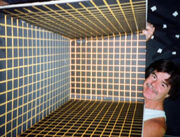
Dennis Hoerter with a holodeck model at Image G
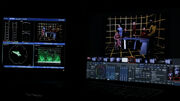
The remastering of a holodeck scene from "A Matter of Perspective"
The concept of the holodeck originated in 1968 , when Gene Roddenberry came up with the idea of a "simulated outdoor recreation area" on the Enterprise for the third season of Star Trek: The Original Series . This idea never came to fruition, probably because of budget constraints. ( Inside Star Trek: The Real Story , p. 404) The idea was later used in the Star Trek: The Animated Series episode " The Practical Joker ", which was basically the first appearance of the holodeck, then called a " recreation room ". It came to existence in live-action production in the pilot of Star Trek: The Next Generation . Its inclusion in that series was originally proposed by Robert H. Justman , who initially thought of and suggested it as a place where crew members could be "psychically connected" with their homeworld. ( Starlog issue 115, p. 71)
In early episodes of TNG, the series' production staff had an unwritten rule that the floors in a holodeck simulation shouldn't go below the floor level of the holodeck's door. This made sense, as burrowing down to the deck below would probably be inadvisable on a starship. Subsequent story requirements and set designs eventually influenced producers to alter their "rule," deciding that at least one holodeck was a multi-story chamber. ( text commentary , Star Trek Generations (Special Edition) DVD )
The appearance of the holodeck on TNG was affected by having limited finances. Production Designer Herman Zimmerman commented, " We were in a budget constraint that made us do a set that is a wireframe look. " Zimmerman and other members of the design team that worked on TNG had a long-standing interest in demonstrating the machinery of the holodeck from inside the room, though this was not made possible until the advent of the Cardassian holosuite in Star Trek: Deep Space Nine . ( The Deep Space Log Book: A Second Season Companion )
Despite the fact that the Galaxy -class starship was meant to have numerous holodecks, a single set represented these environments on TNG. This was one of the last sets to be built for the show and was also used to represent the Galaxy -class cargo bays , shuttlebays , and gymnasium . ( Star Trek: The Next Generation Companion , 3rd ed., p. 10)
The holodeck arch was a prop that was originally made for TNG : " Haven ". Although some holodeck programs incorporated the arch to make the task of finding the way out easier, the arch originated as a way to let outsiders know when it was safe or appropriate to enter. ( text commentary , Star Trek Generations (Special Edition) DVD ) The same arch set piece was featured in both TNG and the film Star Trek Generations . ( Cinefex , No. 61, p. 69)
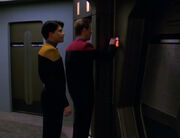
The exterior of an Intrepid -class holodeck, mid- 2371
For its first appearance on Star Trek: Voyager in " The Cloud ", the exterior of the holodeck was the same set piece as had previously been seen on TNG, right down to the octagonal door frame, although all had been repainted to match the color scheme for the new Voyager corridors. It did not receive a square door arch and updated door panels until its second appearance.
There are many discrepancies between episodes pertaining to the abilities and limits of holodeck technology. For example, in " Encounter at Farpoint ", the young Wesley Crusher remains wet with holodeck water, after exiting into a corridor. In " Elementary, Dear Data ", a piece of paper given to Data by James Moriarty is able to be carried outside of the holodeck and into a hall, but upon Moriarty's return in " Ship In A Bottle ", a book thrown outside of the holodeck instantly disappears.
Also, in " The Big Goodbye ", Cyrus Redblock and Felix Leech disappear slowly after a few moments outside of the holodeck, although a lipstick smudge from a holographic character stays with Picard all the way onto the bridge. Although these inconsistencies can be partially explained by the difference in the types of objects leaving the holodeck, it still leaves quite a few questions about what exactly constitutes the differences. The holodeck can use a degree of replication to make realistic objects for the holodeck occupant to use, so there is a possibility of the computer replicating a real piece of paper with the picture on, as it would be a relatively simple pattern.
Some may argue that another discrepancy is the need for holodeck users to change into the appropriate costumes before entering and leaving the holodeck, since the holodeck has the ability to change the appearance of its users (established in ENT : " These Are the Voyages... "). But this may just be an issue of taste, on the user's possible preference of replicated clothes versus holographic clothes. Another theory is that the settings of the holodeck can be altered to not only make weapons be lethal as seen in Star Trek: First Contact in which Picard kills the Borg in a ballroom suite with a machine gun but also to make what events transpired inside it real life like the aforementioned lipstick smudge on Picard
Actor Robert O'Reilly once remarked that, when he appeared as Scarface in TNG : " Manhunt ", he "really didn't understand the holodeck." ( The Official Star Trek: Deep Space Nine Magazine issue 16 , p. 24)
Ultimately, it is evident to longtime viewers of the Star Trek franchise that the holodeck is a storytelling device, like many other aspects of the shows, and only behaves consistently within narrative bounds.
From the Star Trek Encyclopedia , 4th ed., vol. 1, p. 344, "Star Trek writer-producer Ronald D. Moore argued that in a free society of responsible citizens, there should be little or no limit on what an adult can do in a holodeck. Even if others might find certain activities objectionable, what one does in one's private space is no one's business; certainly not the government 's. Of the argument that certain activities should be prohibited on the grounds that they might be harmful or addictive to a holodeck participant, Moore suggested that in a free society, a responsible adult must be permitted to judge risks to his or her own well-being, and to act accordingly. Moore conceded that there might well be circumstances in which someone might object to being replicated on a holodeck, but notes that it would be extremely difficult to define legally what constituted fair use and what was abusive. (Moore emphasized that he referred to holodeck usage by adults, not by children.) "
The holodeck is one of the prominent examples of Star Trek predicting technology, like VR, MR, and AR.
See also [ ]
- Computer-generated imagery
- Federation holoship
- Holoprogram
- Holotechnology
- Synaptic stimulator
- Visual simulator
External links [ ]
- Holodeck at Memory Beta , the wiki for licensed Star Trek works
- Holodeck at Wikipedia
- 1 USS Voyager (NCC-74656-A)
- 2 Star Trek: Prodigy
- 3 Daniels (Crewman)

Seth Lugo’s “Art of Pitching” Lands Him First All-Star Game Appearance
At 34, another milestone in Seth Lugo’s baseball journey has arrived.
In his first campaign as a Kansas City Royals rotation member, Lugo has proven that the decision to transform back into a starter two seasons ago was indeed the right one, culminating in the announcement on Sunday of his first-ever MLB All-Star Game nomination.
Have all the intel you need? Free actionable info is one click away! Sign up for our daily newsletter, SportsGrid Daily.
The choice to include Lugo as a member of the American League squad could be one of the easiest ones regarding the Midsummer Classic. After allowing two earned runs in 6.0 innings in a 3-1 loss to the Colorado Rockies on Saturday night, Lugo’s ERA rose to 2.21, still the best among all MLB starters. Lugo’s outing on Saturday was also his 15th quality start of the season in 19 outings, leading MLB hurlers in that category.
Look at Lugo’s page on Baseball Reference, and you will see plenty of areas where he is either leading the league this season or setting personal bests this season.
The numbers tell a simple story… Lugo bet on himself in the offseason before the 2023 campaign, sharing his intention to become a starter again after spending most of the previous five seasons in the New York Mets bullpen. That wager has paid off for himself and the Royals in 2024.
“He’s been one of the elite pitchers in the game,” Kansas City manager Matt Quatraro said. “He’s eaten up innings at a record pace. He’s been up there in almost every category. He’s been a huge part of what we do, on the field and in the clubhouse.”
https://twitter.com/PitchingNinja/status/1807502496505729518?ref_src=twsrc%5Etfw
With the Royals sitting at 48-43 heading into Sunday’s finale and very much in the AL postseason race, Lugo and three other Kansas City players ( Salvador Perez, Cole Ragans, and Bobby Witt Jr. ) will make the trek to Arlington for the Midsummer Classic. Three of those (all but Perez, who is making his ninth All-Star appearance) will be a part of the festivities for the first time, including Lugo.
“Coming up, I didn’t think I would be here at this stage in my career,” Lugo said. “It’s not the journey I thought I was going to be on, but I knew when I was younger in my career that I could sustain some stuff. I could play later in my life. I knew that age wasn’t going to be an issue. It’s been a little bit of perseverance and determination, but it’s a good feeling.”
That “good feeling” could extend even further in Arlington as Lugo is one of the prime candidates to start on the mound for the American League. He and Ragans represent the first Kansas City pitchers to be named All-Stars since the 2017 season when Jason Vargas earned the honor.
“There are only two starters every year for the All-Star Game. It would be really special to be that guy,” Lugo said.
And it would be even more validation for Lugo that he made the right decision to push to be a starter when he left Queens.
“For me, it’s not a matter of accolades or awards for myself and what I’m trying to do. I have my own standards and goals and I’m trying to work my way towards those,” Lugo said. “But, from the outside looking in, that would be pretty special.”
With a wide variety of pitches at his disposal, Lugo has become not only a crafty veteran pitcher but one who has multiple weapons in his arsenal. In his start on Saturday, per Baseball Savant, Lugo used eight different pitches to keep Colorado batters off balance.
It’s one thing, however, to have a variety of pitches. It’s another to be able to throw them effectively, Quatraro said.
“He has a great pitch mix, but he executes, and he keeps hitters off balance,” Quatraro said. “He has refined the art of pitching.”
Yes, it’s another step along Lugo’s journey, but the Royals hope it will continue toward more success for the right-hander and the team.
The post Seth Lugo’s “Art of Pitching” Lands Him First All-Star Game Appearance appeared first on Just Baseball.
Stay ahead of the game and elevate your sports betting experience with SportsGrid .


IMAGES
VIDEO
COMMENTS
First appearance: Star Trek: The Next Generation: Created by: Gene Roddenberry: Genre: Science fiction: In-universe information; Type: ... Starfleet: In Star Trek a replicator is a machine that can create (and recycle) things. Replicators were originally seen to simply synthesize meals on demand, but in later series much larger non-food items ...
A replicator, replicator system, replication system, or molecular synthesizer was a device that used matter-energy conversion technology similar to a transporter to produce almost anything from a ship's replicator reserves. (TNG: "Lonely Among Us", "Deja Q"; DS9: "Visionary"; VOY: "Virtuoso"; ENT: "Dead Stop") It was also capable of inverting its function, thus recycling the item. (DS9: "Hard ...
There are no direct references to replicator use aboard the E-B, E-C or Stargazer or any of the other older vessels that made an appearance in TNG stories. Then again, the TNG food replicator prop was used for decorating Kirk's cabin in ST6. Probably it was playing the demanding role of a simple storage cabinet there, though.
When Starfleet first takes to the stars with the NX-01, they haven't yet developed replicator technology, instead relying on a combination of food from their hydroponic greenhouse, resupplied ...
You might want to clarify that, as you're getting both sorts of answers. And a vast difference between the inventor of the "Trek Replicator" (in-universe) and the concept of a replicating machine. I'm not sure why this is tagged "star trek" at all given that the answer chosen is much closer to the concept of the replicators from Stargate ...
Of course, Star Trek uses replicators for more than just food, with the matter-energy converters being used to synthesize medicines, clothing, equipment, and much more. Industrial replicators can even be used to create machinery and in construction projects. They also contain scanners, allowing them to scan the structure of an object in order ...
In Star Trek a replicator is a machine that can create (and recycle) things. Replicators were originally seen to simply synthesize meals on demand, but in later series much larger non-food items appear. ... Star Trek franchise element: First appearance: Star Trek: The Next Generation: Created by: Gene Roddenberry: Genre: Science fiction: In ...
Star Trek envisions the future of humanity to be one of incredible achievements made possible by evolved philosophies as well as technologies. This hopeful view of tomorrow is perhaps the reason so many have dreamed of inventing real-life versions of Star Trek tech -- from the transporter to the tricorder -- and the replicator is one of the most coveted.From a scientific perspective, aspects ...
To trace the roots of Star Trek's replicator, ... did not invent the concept of matter transmission. Its first appearance in science fiction dates back at least as far as 1877, in Edward Page ...
In the TV franchise Star Trek, this is possible with a piece of technology known as a "replicator.". Getting to a future where this tech exists, though, might take a bit of imagination and invention. The Star Trek replicator is used to make all kinds of objects, from a hot cup of Earl Grey tea to spare parts for spaceships.
Warning: contains potential spoilers for Star Trek: Defiant #19!. The Star Trek franchise is home to more than a few great bromances, and now one of the best of all time is returning. IDW's Star Trek line, including Star Trek: Defiant, has crafted a large, overarching story bringing together characters from many iterations of the franchise.Now, in a first look at September's Star Trek ...
But, according to Larry Nemecek's invaluable sourcebook "The Star Trek: The Next Generation Companion," Jellico almost made an appearance in the 1993 episode "Tapestry," back in command of the ...
Star Trek has been prescient about future technology ever since showing off a nascent cell phone in the pilot episode of the original series. But that doesn't make the creation of this real-life replicator any less astonishing.. Throughout the incarnations of Star Trek, the replicator has produced a variety of human necessities to the good Starfleet folks exploring the outer reaches of space ...
Replicators are essential machines in the "Star Trek" universe. This device can reproduce food, tools, and sometimes even random viruses. Depending on the writer's imagination, it can make almost anything. In times of need, the replicator is the only thing that can feed the crew. And being so far from Federation ports and basses, replicators ...
In short, Chakotay seemed like the character least likely to return for any of Star Trek's modern sequel series, even as Prodigy made Janeway's search for her former XO a key plot point. So ...
The replicators work primarily by converting energy into matter. While the specifics of this are not officially canon, the general consensus is that they use the energy they are fed to rearrange ...
See: Star Trek Next Generation: S4-EP17 Night Terrors. It is explained that certain items can not be replicated based on materials on board. Latinum is explained as the most Dense and heavy substance in the Universe. For this reason, the Replicators would need something just as dense atomically or greater to replicate. Which is impossible.
As a Star Wars fan, writing stuff about "Trek" is a bit awkward. Nonetheless, the replicator is a fascinating machine. The replicator made its first real appearance in The Next Generation series of Star Trek already in 1987. In older Star Trek series, there were hints towards a replicator but only as a bio-matter or protein re-sequencer.
Replicators in Star Trek begin as a way to make food (ENT: Fight or Flight) using proteins (for ENT) or organic molecules of an ill described nature (TOS, TNG, DS9, and VOY).This "protein resequencer" rearranges amino acids in proteins to produce other proteins (with some exceptions) for Captain Archer and his crew, while several decades later, Spock, Kirk and the Constitution class ...
The Star Trek: The Original Series episode, "Errand of Mercy" includes the first appearance of one of Star Trek's most iconic aliens — the Klingons. Throughout its three seasons, TOS produced some truly memorable episodes of television, many of which continue to affect the Star Trek franchise today.The adventures of Captain James T. Kirk (William Shatner) and the USS Enterprise crew laid the ...
Stage 6 on Thursday is again suited for sprinters, going through vineyards to Dijon on a mainly flat trek of around 100 miles. The first individual time trial is on Friday. The Associated Press
So a replicator is just a follow-on to transporter technology. If this is an accurate description of Star Trek replicators, then a replicator can replicate itself as long as it has a digital pattern and a source of the right bulk material to work from. 1 Unfortunately, I have no chance of finding a reference for that now.
Genre: Star Trek (animated YA adventures edition) Release date: July 1, with all episodes Showrunner/creator: Kevin and Dan Hageman Cast: Brett Gray, Ella Purnell, Jason Mantzoukas, and more ...
He and Ragans represent the first Kansas City pitchers to be named All-Stars since the 2017 season when Jason Vargas earned the honor. "There are only two starters every year for the All-Star Game.
Chief among these are transporter-based replicators. These devices permit replication of virtually any inanimate object with incredible fidelity and relatively low energy cost. There are two main replication systems on board the Enterprise. These are the food synthesizers and the hardware replicators.
A Star Trek-like replicator has arrived, but don't expect it to synthesize a cup of Earl Grey tea (hot) on the spot.Researchers have come up with a new 3D printing technology that rapidly makes whole objects appear, seemingly from nowhere. There is a wide array of 3D printing technologies out there. Most build objects by solidifying gels or plastics layer by layer, in many cases taking hours ...
Maybe, but in the universe of Star Trek which has stuff like warp drives, replicators, transporters, holodecks, telepathy, etc there are a lot bigger technical problems out there IMO. Maybe someone in Star Trek has invented a way to harness the energy of nuclear explosions and put it back in the replicator batteries lol.
For its first appearance on Star Trek: Voyager in "The Cloud", the exterior of the holodeck was the same set piece as had previously been seen on TNG, right down to the octagonal door frame, although all had been repainted to match the color scheme for the new Voyager corridors. It did not receive a square door arch and updated door panels ...
The post Seth Lugo's "Art of Pitching" Lands Him First All-Star Game Appearance appeared first on Just Baseball. Stay ahead of the game and elevate your sports betting experience with ...
In Star Trek, Starfleet uniforms and other clothing is made by replicator patterns. ... It can be designed in such a way as to minimize or enhance the appearance of certain physical traits - a well tailored suit can make a person look slimmer and more fit. ... Why can't Star Trek replicators scan individual bodies for perfect fit like ...